December, 2019 ZEST WISHES

Prepared by scraping or cutting the outermost rind - the flavedo or exocarp of unwaxed citrus - such as citrons, lemons, limes, or oranges, citrus zest is a popular culinary ingredient. Together, the flavedo and inner rind - pith, albedo or mesocarp - makes up the peel. Zest and peel are used to flavor everything from liquors like Licor de Oro and dishes like Ossobuco Alla Milanese, to baked goods and confectionaries; as a spice in sauces and salad dressings; as a condiment in Sweet and Sour, Lemon Pickle, and Lime Chutney; or as a garnish for drinks, cocktails and desserts. Zest is also used in things like body scrubs, face masks, and cleaning products, lending a pleasant aroma and anti-bacterial properties. Citrus zest and peels are rich in fiber and flavonoids - compounds that work with the immune system - helping to avoid inflammation and fight illness. Zest also contains phytochemicals - antioxidants that help improve overall health, the vitamins A and C, as well as potassium, calcium, and magnesium.
"ZEST" comes from the 17th century French word 'zeste,' originally referring to the culinary ingredient and later adopted into English - with an additional metaphorical meaning referring to anything that adds enjoyment - as citrus zest adds flavor to food.
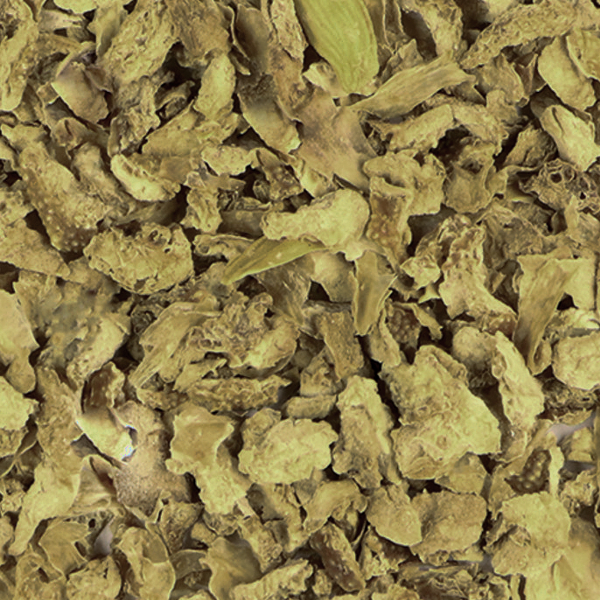
Lemon zest is most commonly used for sweets or with fish and seafood, and Duck a L'orange is a French classic, many times paired with fennel. There is also Carne de Puerco a la Naranja or Braised Pork in Orange Sauce, the basis for modern Cuban pork sandwiches or Cubanos. Minced dried orange or tangerine peel is a staple in southern China, where oranges originated, and in Morocco, pickled and preserved lemons are almost always found in kitchen pantries and Tangines. Lime zest has been used in Thai, Sri Lankan and Hispanic cuisines for centuries, included in Native American recipes by the 16th century. In general, fruits with peel that is mostly flavedo are referred to as mandarines, and their peel can be used whole; pomelos, grapefruits, and citrons tend to have a thicker and more bitter pith. The pith of lemons, limes, and oranges is less bitter, and can be used whole for things like Marmalade or candied Succade.

Many of my favorite recipes call for some kind of citrus zest, so I like to keep fresh oranges, lemons and limes on hand. However, if you're just using the zest it can be wasteful, especially if you don't use what you have in time. Luckily you can find dried zest products available from quality spice manufacturers, and citrus zest is easy to freeze or dry at home. The white pith is usually bitter and unpleasant, so it's generally not used when zesting, but when you purchase dried peels, be aware that pith is often included. This makes dried peel much more intense, so it's recommended that you only use a third of the peel when substituting for the zest in a recipe. When you freeze or dry your own zest you can adjust the flavedo to pith ratio to your liking.

NOTE: When cooking with zest, the most straightforward tool to use is a microplane or fine grater. This creates very small pieces of fresh zest that are easier to work with but they are not as versatile for drying. You can also use a citrus zester, specifically designed to zest citrus - or any sharp shred-style grater that you have - you can always mince or chop the shreds into smaller pieces.
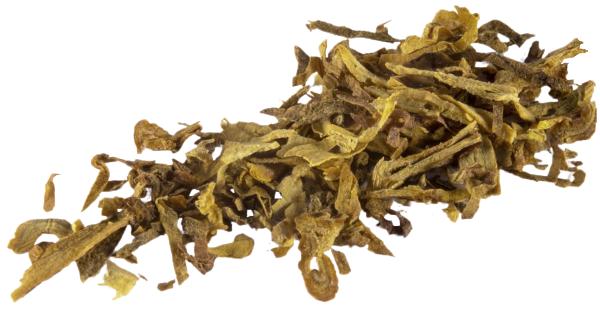
A vegetable peeler or paring knife can be used to trim your peel into in larger pieces. These strips can be stored for three months or longer in the freezer - simply spread them out on a flat surface to freeze individually and then transfer them to an airtight freezer storage bag. For drying, spread them out on parchment paper in a single layer with space in between each piece and dry them in the sun for 3 to 4 days, bake them in the oven at a very low temperature - the lowest setting or 150-250° - checking regularly, or dry them in a dehydrator for anywhere from several hours to a couple days, depending on the type of citrus and the size of the pieces. They are finished when they crack and snap instead of bend. When freezing or drying smaller pieces or grated zest, you'll need to check on them regularly and mix them around, making sure they freeze or dry evenly.
After you've acquired dried citrus zest, you can pulzerize it in a blender, food processor, or spice grinder and turn it into powder. Sift it using a fine mesh strainer and repeat the process until you get the consistency you like. Use this to add the tangy zing of citrus zest without the texture, great for making seasoning blends, mixing with sugar or salt, sprinkling as a condiment, or infusing into butter, oil and sometimes cream. Lemon powder is great on avocado toast, lime powder on tacos, and try some orange powder in your herbal tea.
November, 2019 HYSSOP, OREGANO + ZA'ATAR

The Middle Eastern spice mixture Za'atar almost always includes the herb za'atar as a main ingredient, which is a form of wild oregano, but the savory herb blend colloquially includes hyssop, a mostly medicinal herb from antiquity. Let's take a closer look.
{ HYSSOP }
Hyssopus Officinalis: From the Lamiaceae family, part of the Lamiales (mint) order. A brightly coloured shrubbery with antiseptic properties, hyssop is traditionally used as a medicinal herb, cough reliever, and expectorant; thought to increase circulation and stimulate the gastrointestinal system. Ancient Romans believed hyssop protected them plague, and hung dried hyssop in their homes to keep out negativity and ward off "evil eyes."
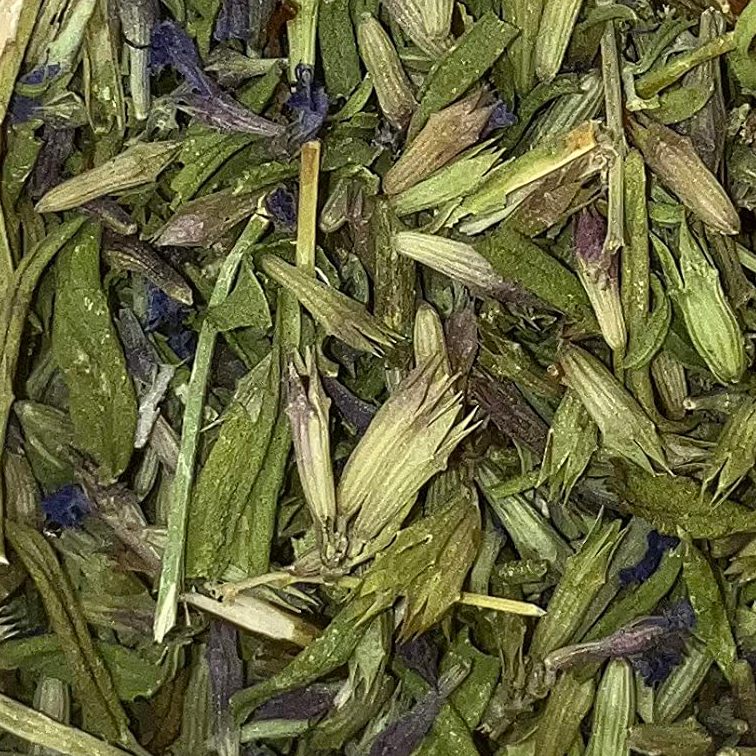
"HYSSOP" is a direct adaptation of the Greek 'hyssopos,' similar to the Hebrew 'ezov,' 'esov,' or 'esob;' also deriving from the Hebrew 'ezob,' which translates to "holy herb."
Hyssop both looks and tastes a bit floral, like lavender, but with a minty bitterness caused by tannins. Dried hyssop is most commonly used to make herbal teas and natural cough suppressants, and steaming the herb can help diminish the intensity for culinary use. Hyssop leaves are sometimes used as an aromatic condiment, replacing mint in the preparation of lamb, but the herb is more commonly used to flavor liquors like Chartreuse, serving as the main source of the green color in many formulations of Absinthe.
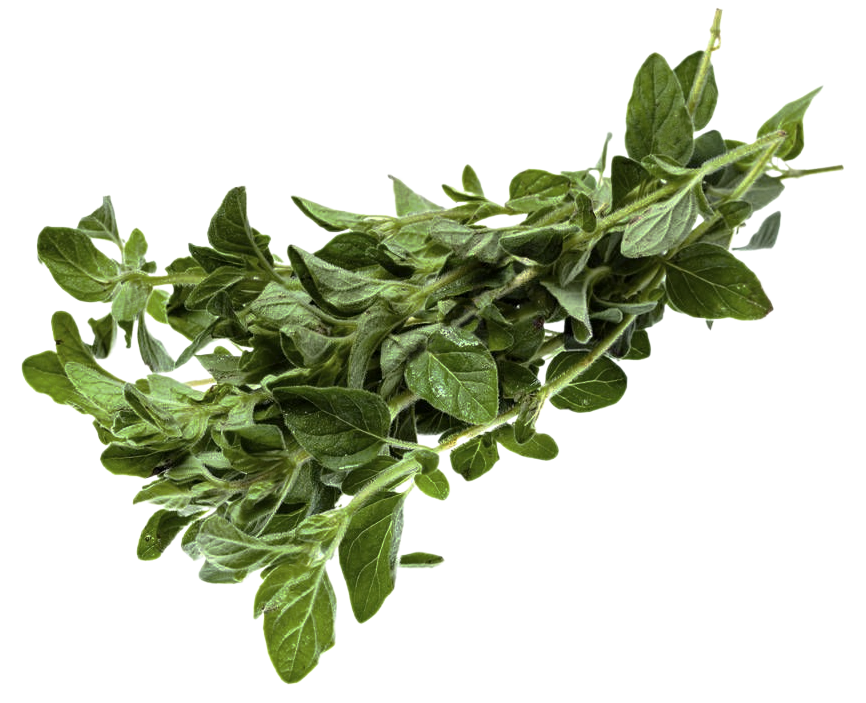
{ OREGANO }
Origanum Vulgare: From the Lamiaceae family, part of the Lamiales (mint) order. A culinary herb and ornamental plant, oregano is also referred to as "European oregano," "pot marjoram," "wild marjoram," "winter marjoram," or 'wintersweet;' closely related to Origanum majorana, or "sweet marjoram." Oregano is primarily used for the flavour of its dried leaves, which can be more intense than fresh, with an warm, earthy, slightly bitter taste, varying in intensity depending on the cultivar. Good-quality oregano is spicy and pungeant, and should almost numb the tongue - with the chemical compounds carvacrol, thymol as in thyme, along with limonene, pinene, ocimene, and caryophyllene contributing the flavor. Some studies suggest that the phytochemicals in oregano can help relieve cough, muscle spasms, and infections. There are many subspecia of oregano, not always suitable for culinary use, and many other plants that are referred to as oregano, all with very similar tastes and characteristics as standard oregano.

"OREGANO" derives from the middle 18th century Spanish 'orégano,' from the Latin 'orīganum,' via the Classical Greek 'orīǵanon.' The term could be a combination of 'óros' or 'mountain,' and 'gános' or 'joy,' translating to "joy of the mountain;" but this origin is disputed.

Oregano is often found in Greek, Italian, Spanish, Turkish, Hispanic, and French cuisine. Full sprigs of oregano can be used in the stuffing for poultry or fish, adding a subtle flavor to the meat while cooking. Oregano is often added to pasta and rice dishes, used to season ground meats and grilled seafood, in salad dressings and homemade pesto, as well as many condiment spice blends.

I like to use whole oregano because the leaves alone taste too similar to marjoram, but there are other versions of oregano available. One of my favorites is Turkish Oregano Buds. These beautiful, pinecone-shaped oregano flower buds are hand-picked just before they open into flowers, with a bright, spicy kick, like zesty hops. Use them anywhere you would use regular oregano for some extra flavor, or for their fancy floral appearance and texture.
{ ZA'ATAR }
Origanum Syriacum, Majorana Syriaca, and Origanum Maru: From the Lamiaceae family, part of the Lamiales (mint) order. Commonly referred to as "Bible hyssop," 'Biblical-hyssop,' "Syrian oregano," "Lebanese oregano," "Arabic oregano," "Arabian oregano," "wild oregano," or "wild Grecian oregano;" the herb za'atar is considered to be 'ezov' of the Hebrew Bible, often called hyssop in translation but unrelated to Hyssopus officinalis. Za'atar was nearly foraged harvested to extinction, and is protected under Israeli law as an endangered plant - but due to high levels of demand it has recently entered cultivation. The main difference between za'atar oregano and regular oregano is that za'atar is mostly underdeveloped buds and very few leaves.

"ZA'ATAR" is both a herb mixture and a family of herbs, possibly deriving from the ancient Akkadian 'sarsar' or "spice plant," the Syriac 'satre,' and the Latin 'satureia' or 'satureja,' which is a common name for Satureja thymbra, a species of savory. "Persian za'atar," "za'atar rumi" or "Roman hyssop," and "za'atar franji" or "European hyssop" are references to Satureja thymbra as well. In addition, common oregano is otherwise known as "wild za'atar" or "za'atar barri," and the word za'atar has also been used to reference Origanum majorana or "sweet marjoram."
The herb mixture Za'atar is often comprised of oregano flower, toasted sesame seeds, sumac, thyme, marjoram, and hyssop; and may also include toasted cumin, coriander, caraway, or fennel seeds; and aleppo chili flake. For my version I've added ajwain or carom seeds, which must be toasted, and omitted the thyme. I also increased the amount of marjoram and added dried mint leaves to help balance the ajwain and mimic the taste of hyssop, since I don't recommend keeping it on hand unless you are a fan of herbal teas. This is a particularly good spice mix for seasoning lamb.
FC ZA'ATAR:
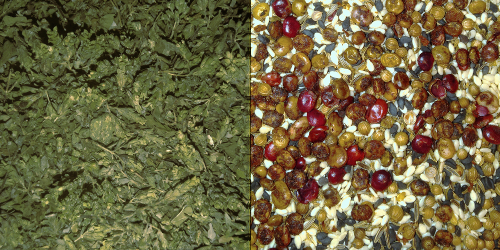
| Wild Oregano | : | 2 tbsp |
|---|
| Marjoram | : | 2 tbsp |
|---|
| Mint | : | 2 tbsp |
|---|
| Sesame Seeds | : | 2 tbsp whole, toasted |
|---|
| Sumac | : | 2 tbsp whole |
|---|
| Black Sesame Seeds | : | 1 tbsp whole, toasted |
|---|
| Coriander | : | 1 tbsp whole, toasted |
|---|
| Cumin | : | 1 tbsp whole, toasted |
|---|
| Ajwain | : | 1 tsp whole, toasted |
|---|
| Aleppo Chili | : | ½ tsp flake, to taste |
|---|
DIRECTIONS:
Small Frying Pan- toast all of the whole seeds over medium-high heat, stirring constantly - do not add oil.
Let Cool- completely to room temperature.
Spice Grinder- pulse all ingredients together until they are well-blended with a coarse to fine grain, store in an air-tight glass decanter.

NOTE: It's generally better to use the whole spices for toasting, but it's perfectly okay to use a little bit less of the pre-ground versions and omit that step. If you don't have aleppo chili, you can subsitute with a pinch of regular chili flake and a pinch of sour grape powder. Sichuan peppercorn is another spicy alternative.
One of the best uses for Za'atar is Manakish - a Levantine flatbread pizza covered in za'atar mixed with olive oil and sometimes topped with fresh milk cheese, tomatoes, onions and ground meats. I like to use 3 tbsp of olive oil and 2 tbsp of za'atar, Lor Peyniri cheese for its high protein content, and thin slices of tomato on Lavash. After it's done baking I add a squeeze of fresh lemon juice and call it breakfast. That's right, pizza for breakfast… again.
October, 2019 POTATO LEEK SOUP
Potage Parmentier: Named for Antoine-Augustin Parmentier (1737–1813), a fench pharmacist and argonomist who was best remembered as an advocate for the culinary use of potatoes and a cofounder of the first government-funded French baking school. To this day, 'parmentier' refers to any culinary dish prepared with potatoes. "Velouté Parmentier," "Créme Parmentier," and "Potage Bonne Femme" are also names for Potato Leek Soup.

"Vichyssoise" [vi-shee-swaaz] : As the story goes, Louis XV of France demanded that his royal court tasted his food for poison before he would eat it, and his Potato Leek Soup was always cold by the time it got to him, but he liked it that way; and a tradition of serving the traditional soup cold was born. The French chef Jules Gouffe is also mentioned as the creator in 1859, but the chilled version of the soup was most notably made popular in 1917 by Louis Diat, a chef at the Ritz-Carlton. He named the chilled, creamy and sometimes blended version of Potato Leek Soup after Vichy, a spa town in France near where he was born, and where Vichy Water comes from. Famously, one of Julia Child's favorite soups was Vichyssoise, and the recipe appears in her cookbook, Mastering the Art of French Cooking, Volume I.
A French classic, and one of the first recipes I learned to make as a child, Potato leek Soup is quick and painless. The hardest part of making the soup is cleaning the leeks! once you get all the sandy dirt from between the leaves and peel the potatoes, you're almost done. There is some speculation out there about whether to blend or not to blend and the 'gluey' texture of the soup. I had always left my soup on the chunky side, but using a potato ricer or only blending a portion of the potatoes seems to be the best technique. You could also use a fine mesh strainer or a food mill, but avoid blending the entire soup because the starch from the potatoes will become sticky and glue-like.
FC POTATO LEEK SOUP:
| Leeks | : | 2-3 large, cleaned and chopped
with greens removed |
|---|
| Potatoes | : | 4-5 medium russets or large
yukons, peeled and diced |
|---|
| Stock | : | 1 quart, chicken or vegetable |
|---|
| Half & Half | : | 2 cups, to taste |
|---|

DIRECTIONS:
Stock Pot- melt the coconut butter over medium-high heat, add leeks and soften for 3-5 minutes, stirring often.
Sift Flour- over pot and stir to coat the leeks, making a roux. Continue to sauté for another 2-3 minutes, reducing heat if necessary.
Add- broth and lightly whisk to combine with leeks and roux, season with bay leaves, salt and pepper.
Add- potatoes to pot and bring to a boil. Cover and reduce heat to simmer for about 15 minutes, or until the potatoes are soft.
At this point you should decide what consistency you're after and mash, use a ricer or puree a portion or all of the soup to your liking. I like to strain my soup through a colander and then rice half of the potatoes and leeks, lightly mash the other half and then add it all back to the pot. If I'm in a hurry, I use an immersion blender for a few minutes and then move on to the next step. If you want to store your soup in the freezer, stop here before you add the half & half and chives. Let the soup cool to room temperature and pour it into freezer-safe containers. Add the half & half and chives when you are ready to thaw, simmer and serve.
Stock Pot- return everything to the pot except the bay leaves, add the half & half and chives, and check seasonings. Bring everything just up to a boil, reduce heat to low and serve.
NOTE: Sometimes I like to start this soup by cooking some thick-cut bacon and using 2 tbsp of bacon fat instead of butter. When the soup is done, I add the crunchy chopped bacon on top with some fried leek greens and fresh chives. Other topping ideas include shredded sharp cheddar, drizzles of cream or infused oil, fried shallots, fresh herbs, green onions or hot sauce. Alternately, you could add watercress for Potage au Cresson.
September, 2019 PERFECTION IN BROILING - Leeks
Allium Ampeloprasum or Allium Porrum: From the Alliaceae family, part of the Asparagales (allium) order. A vegetable similar to a large scallion or green onion, the leek is a bundle of edible leaf sheaths, rich in vitamin K and manganese; also containing the vitamins B6 and C, folate, and iron. Dried leeks were discovered in ancient Egyptian archaeological sites, depicted in wall carvings and drawings from around the second millennium BCE. 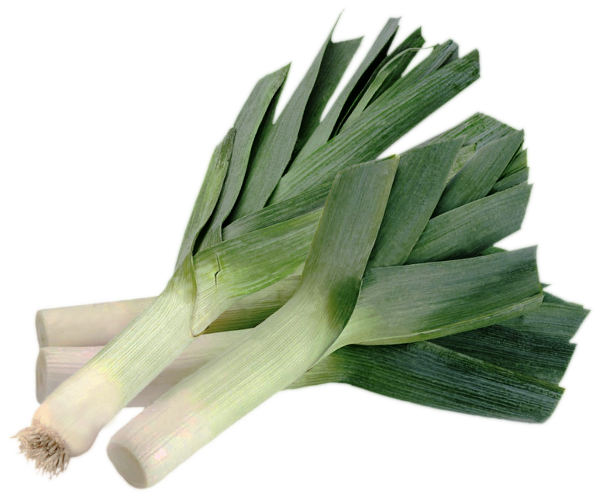 The ancient Romans regarded leeks as superior to garlic and onions, and Apicius, a cookbook from 1st century CE contains four recipes including leeks. Nero, the Roman emperor often credited with the fall of the Roman Empire, consumed such massive amounts of leeks that he was nicknamed "Porrophagus" or "Leek Eater." Both the leek and the daffodil are national emblems of Wales, and the daffodil is known as "Peter's leek."
The ancient Romans regarded leeks as superior to garlic and onions, and Apicius, a cookbook from 1st century CE contains four recipes including leeks. Nero, the Roman emperor often credited with the fall of the Roman Empire, consumed such massive amounts of leeks that he was nicknamed "Porrophagus" or "Leek Eater." Both the leek and the daffodil are national emblems of Wales, and the daffodil is known as "Peter's leek."
"LEEK" is developed from the Old English 'lēac' or 'onion,' based on Old Norse. It is also called 'løg' in Danish, 'laukur' in Icelandic, 'løk' in Norwegian, 'lök' in Swedish, and 'lauch' in German. In Dutch, 'look' is used for Alliums in general.
Leeks have a sweet, onion-like flavor that is mild, and a texture like a cross between cabbage, fennel, and endive. Just like a large scallion, I usually separate the whites from the greens and wash them very well, for they often have dirt and sand in between the leaves at the base of the green parts. They are particularly beautiful sliced in half lengthwise and grilled, or cut into 1 inch rings and roasted. A lot of people discard the greener part of the vegetable, but I always eat those - don't toss them! Sauté them with a little bit of bacon and eat them alongside some eggs and hashbrowns for breakfast, or quickly steam them, let them cool and eat them with salad.
I came up with this recipe for leek gratín because as a teenager I pretty much made every green vegetable under the sun into a gratin, and this was one of the best. It turns out that Leek Gratin is actually a popular dish in Great Britain, I had no idea. I've modified my recipe a bit over the years to be just a little more fancy, as I've learned better cooking techniques, but overall it's remained the same quick and simple side dish that disappears even quicker.
FC LEEK GRATIN:
| Leeks | : | 2 large, halved
and sliced lengthwise |
|---|
| Aged White Cheddar | : | ½ cup, medium shreds |
|---|
| Whole Milk | : | ½ cup |
|---|
| Table Cream | : | ½ cup |
|---|
| Coconut Butter | : | 2-3 tbsp |
|---|
| Flour | : | 2-3 tbsp |
|---|
| Parmesan or Pecorino | : | 1-2 tbsp, thin sliced |
|---|
| Butter or Olive Oil | : | 1 tbsp |
|---|
| Sel Gris or Sea Salt | : | 1-½ tsp divided, to taste |
|---|
| FC Achiote Seasoning | : | ½tsp divided, to taste |
|---|
| Pepper | : | ¼ tsp, to taste |
|---|
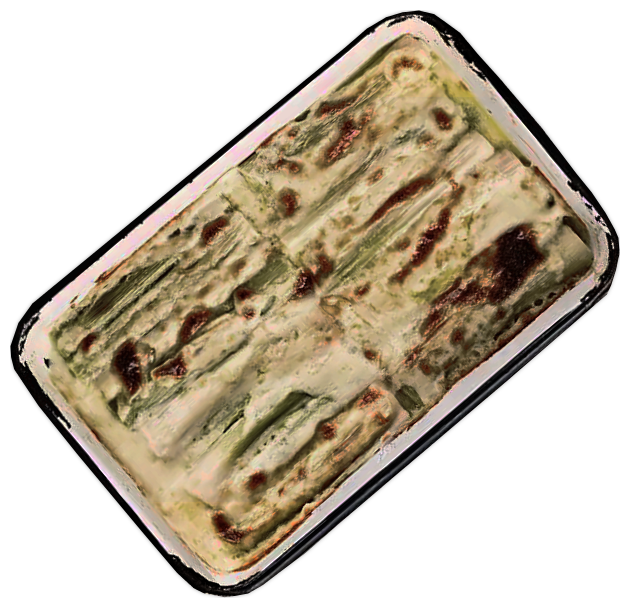
DIRECTIONS:
Preheat Oven- to 350°. Wash leeks thoroughly in between leaves but keep stalks together.
Cast Iron Skillet- heat butter or olive oil in skillet on high until HOT. Add leek halfs, cut-side up and sear 1-2 minutes per side.
Reduce Heat- to medium-low with cut-side down, deglaze with a splash of water and cover to steam slightly, 2-3 minutes or until crisp tender.
Glass or Nonstick Baking Dish- transfer leeks cut-side up, season with half the achiote mixture and half the salt and bake on center rack 10-12 minutes.
Saucepan- while leeks are baking, make a roux with the flour and coconut butter over medium-high heat until just starting to brown.
Whisk- milk, table cream and cheeses into roux. Season béchamel with pepper and the remaining salt to taste.
Remove Leeks- from oven and preheat the broiler, pour béchamel over the leeks and spread evenly with a spatula.
Broil- leeks for 1-2 minutes or until béchamel is slightly browned and bubbly. Season with remaining achiote to taste.
NOTE: If you don't have the FC Achiote Seasoning, you can use the FC Benedict Seasoning, FC Fuchsia, aleppo pepper flake and lemon, or just smoked paprika.
August, 2019 CHIVES
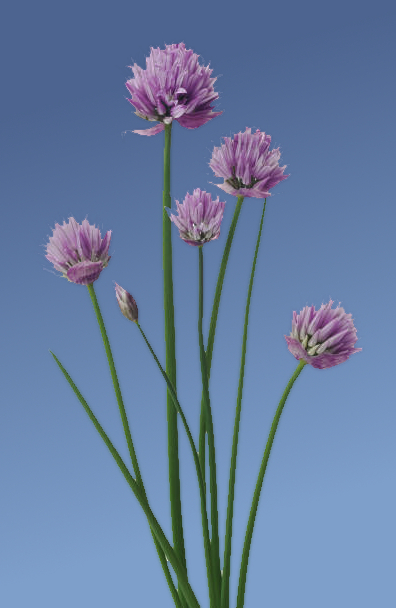
Allium Schoenoprasum or Allium Sibiricum: From the Amaryllidaceae family, part of the Asparagales (asparagoid lily) order. A commonly used herb related to onion, scallion, garlic, leek, and shallot, chives also have clusters of pale purple edible flowers, star-shaped with six petals. The grass-like leaves are shorter than the scapes or stems, and teret or hollow and tubular; formally described in the seminal 1753 publication 'Species Plantarum' by Swedish botanist Carl Linnaeus.
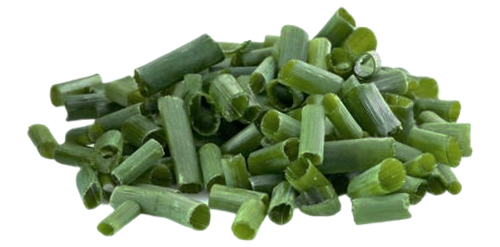
"CHIVE" derives from the French 'cive,' from the Latin 'cepa' or 'onion.' 'Schoenoprasum' derives from the Greek 'skhoínos,' meaning 'sedge' or 'rush,' and 'práson' or 'leek;' and in the Middle Ages, chives were known as "rush leeks."
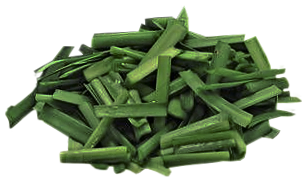
 Allium Tuberosum, or garlic chives - also referred to as "Oriental garlic," "Asian chives," "Chinese chives," or "Chinese leeks" - are an herb very similar to chives, but they have flatter strap-shaped leaves with triangular bases, and produce small white flowers in an umbel or round cluster, and a flavor more similar to garlic than onion.
In North America, the plant is cultivated for ornamental use more than culinary, but in Eastern Asia the leaves, stalks, and immature, unopened flower buds are used as a flavoring as well as in traditional medicine.
The Zhou Dynasty from the 8th or 9th century CE recorded using a garlic chive flower sauce to enhance the flavor of mutton, noting that the flowers were good as both a dipping sauce and a pickled snack.

*The fabled garlic chive condiment is made by fermenting ground garlic chive flowers in salt, sesame oil, sichuan pepper, ginger and garlic. After the fermentation process, it's mixed with rice vinegar and sesame paste or tahini to temper the saltiness.
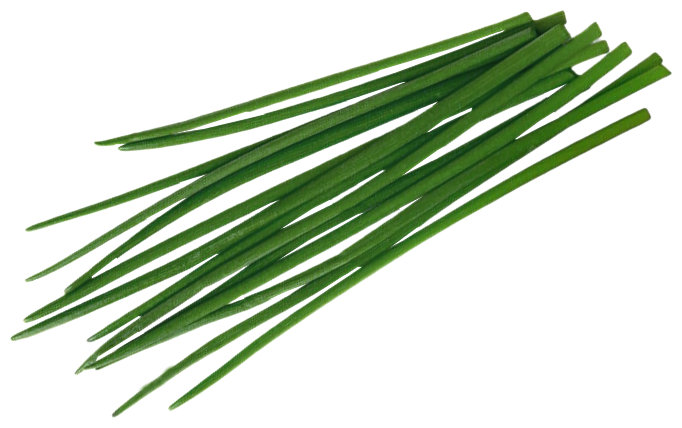
Chives are one of the "fines herbes" of French cuisine, along with tarragon, chervil and parsley, and can be dry-frozen without sacrificing flavor.
Dried chives are one of my favorite herbs to throw around the kitchen, stemming from a longtime love of baked potatoes. These Chive Mashed Potatoes are so good there's no gravy necessary.
FC CHIVE MASHED POTATOES:
| Chives | : | ¼ cup minced, divided |
|---|
| Alaea Salt | : | 1-1½ tsp, to taste |
|---|
| Pepper Medley | : | ¼-½ tsp, to taste |
|---|
DIRECTIONS:

Large Saucepan or Pot- bring water to a boil, add potatoes and boil until fork-tender.
Small Saucepan- heat coconut butter, 1 tbsp of the chives, half the salt and pepper on medium-low to low while potatoes cook - do not simmer.
Large Mixing Bowl- whisk cream with a cake mixer until peaks form - (optional step)
Colander- drain potatoes and return to large saucepan or pot, add butter mixture and mash until desired consistency if achieved. You may want to use a food processor if you prefer a creamy texture.
Large Mixing Bowl- add potato mixture to beaten cream, the remaining salt and pepper to taste, and the rest of the chives - reserving 1 tbsp for garnish. Fold together, being careful not to over-mix.
NOTE: If using red or russet potatoes for this recipe, I suggest leaving the skin on, but it's up to you. As a reminder, "coconut butter" is 2 parts coconut oil and 1 part butter. You can use sour cream as an alternative to cream and omit the whisking step - you might want to reduce the amount of salt also.
July, 2019 
PASS THE SALT?
Sodium Chloride: NaCl (ionic compound)
A colorless, crystalline mineral used to improve the taste perception of food. The natural mineral formation of sodium chloride or rock salt is referred to as 'halite,' derived from 'háis,' the Ancient Greek word for salt. Pickling salt is the purest from of sodium chloride available for food use, also called "canning salt" or "preserving salt," and contains no anti-caking agents or iodine, with a very fine grind that dissolves quickly.

Salt is one of the oldest known food seasonings, dating back to around 6000 BC. Primarily composed of sodium chloride, salt is an essential part of many food preservation methods, including salting, brining, and pickling. Most forms of edible salts or table salts include anti-caking agents, are iodised to prevent iodine deficiency, or contain flavorants. They are generally derived from mining or evaporation, identified by their geographic origin or preparation method, impurities, additives and flavors, or their intended purpose. The size of the grind or crystal formation can also play a significant role in the cooking process, such as using ice cream rock salt to make frozen treats, or cooking thinly sliced meats on top of salt slabs. Some healthy salt alternatives include salt-free seasoning blends, lemon juice, lemon zest, or vinegar
THE SHAPES OF SALT:

Pickling or Fine

Table

Kosher (No Iodine)

Coarse

Sea
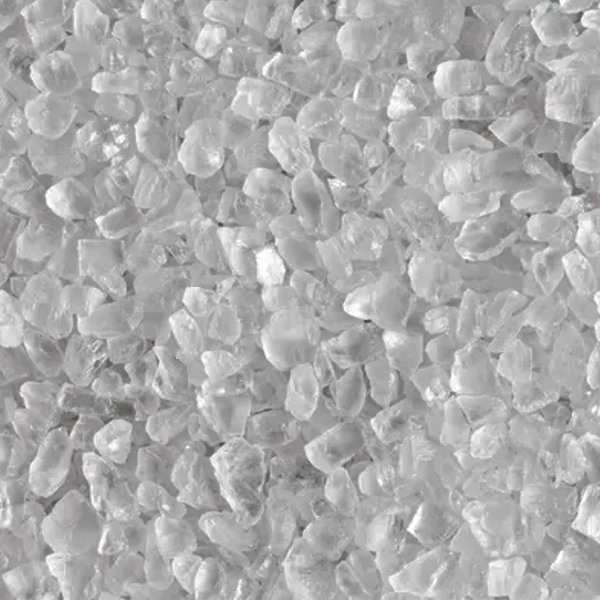
Rock

Ice Cream

Pakistani Chunk

Egyptian Frost Salt:
- Crystalline salt with a texture similar to cotton candy, from Egypt.
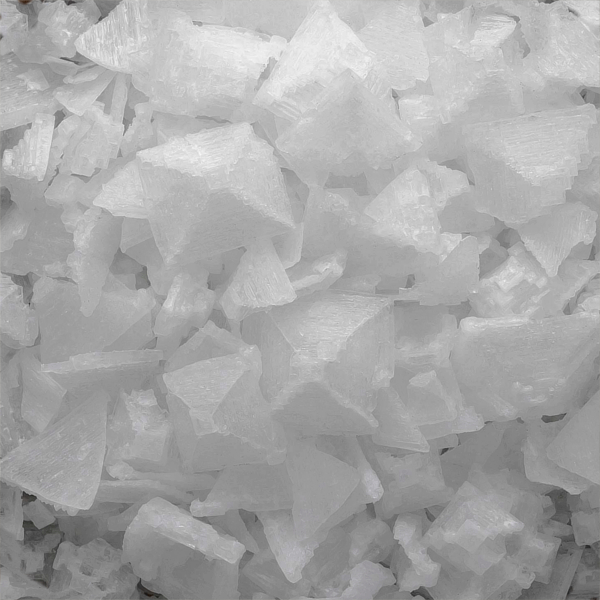
Flake Salt or Pyramid Salt:
- Flake-shaped crystals sometimes resembling pyramids from special evaporation pans. They have a bright taste with a low mineral content, best used for finishing.
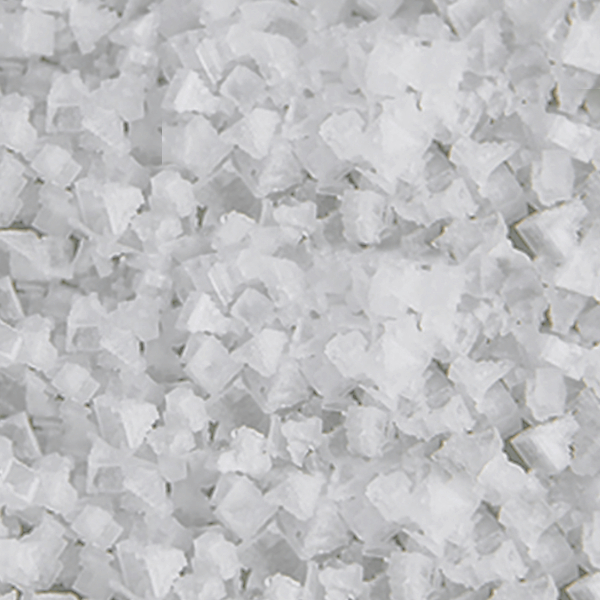
Fleur de Sel or Finishing Salt:
- Hand-harvested sea salt, often from France and traditionally from the coast of Brittany. Fleur de sel means "flower of salt" in French, and its noted to have a briny and moist ocean-like flavor.

Khoisan Pearls:
- Spheres formed by wind tumbling across salt pans and occasionally sea salt tumbled by waves on the shore, from South Africa.

3 Caliber Salt Pearls:
- Large rounded shapes of tumbled halite. Mostly used for metaphysical therapy, but can be shaved or immersed for food use if designated.

Salt Slabs:
- Oversized slabs of salt rock used for slow-heating processes or cold serving techniques.
TYPES OF SALT:
Pink Himalayan Salt: A naturally pink rock salt mined from the foothills of the Himalayas, in the Punjab region of Pakistan. Its color is a result of trace amounts of iron oxide, and it contains less sodium than table salt.

Fine

Table

Coarse

Rock

Whole Chunk
Kala Namak: "Black Salt" in Nepalese, also known as "Himalayan black salt." The salt's deep reddish-brown color is created by roasting rock salt with charcoal, seeds, herbs, and bark in a furnace for 24 hours. The pungent salt has a very distinctive flavor and a sulphurous smell, commonly used in vegan recipes to mimic the taste of eggs, or to enhance the flavor of eggs in ethnic dishes.

Fine

Table

Coarse

Rock

Whole Chunk
Persian Blue Salt: This intriguing blue salt is extracted from an Iranian salt mine in the northern province of Semnan. There are claims that the color is caused by a light refraction in the crystals, and is merely an optical illusion - but it is more likely caused by blue spirulina, an algae substance.

Coarse
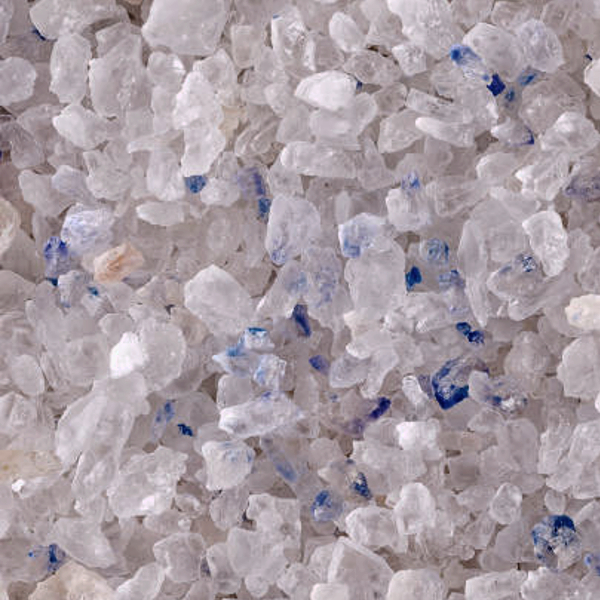
Natural Coarse
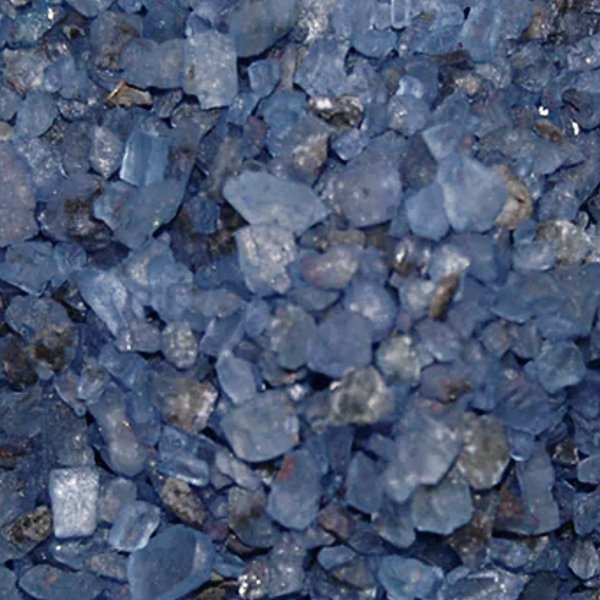
Rock

Natural Rock
Smoked Salts: Created by cold smoking salt with wood (such as alder, apple, hickory, or mesquite) for up to two weeks, the flavor and color of smoked salts can vary depending on the type and method. These are just a few of the popular variations I have seen.
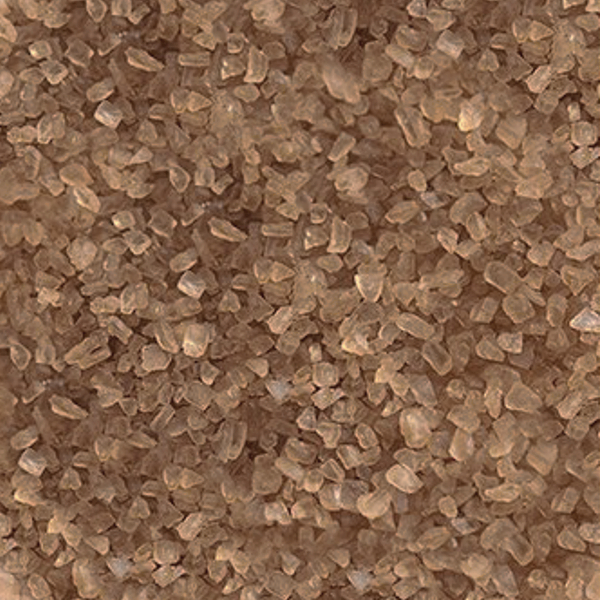
Smoked

Alder or Walnut
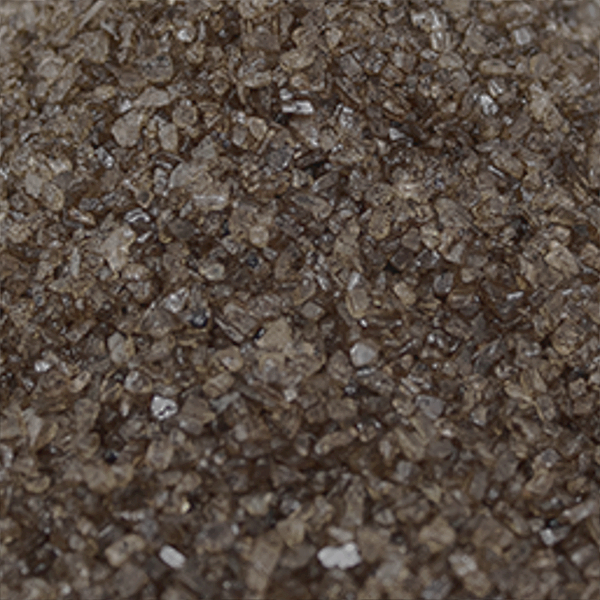
Applewood
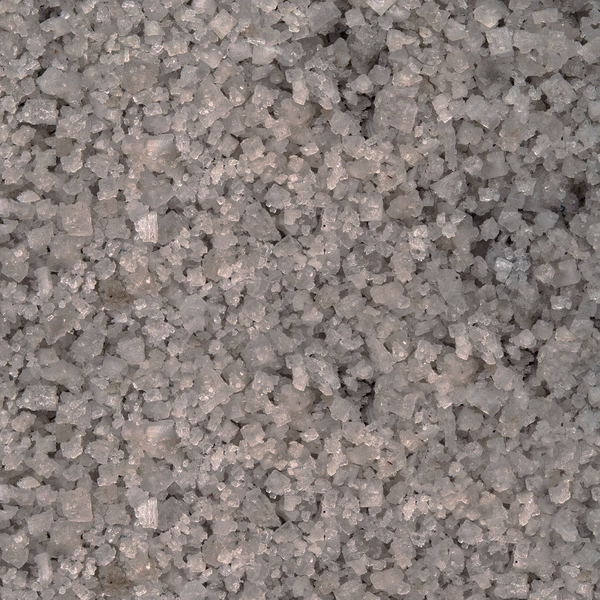
Gray Smoke

Hickory
OTHER SALT VARIATIONS:

Alaea Salt:
- A red volcanic clay and sea salt mixture, rich in iron oxide with a nutty flavor and a striking color, perfect for garnishing, from Hawaii.
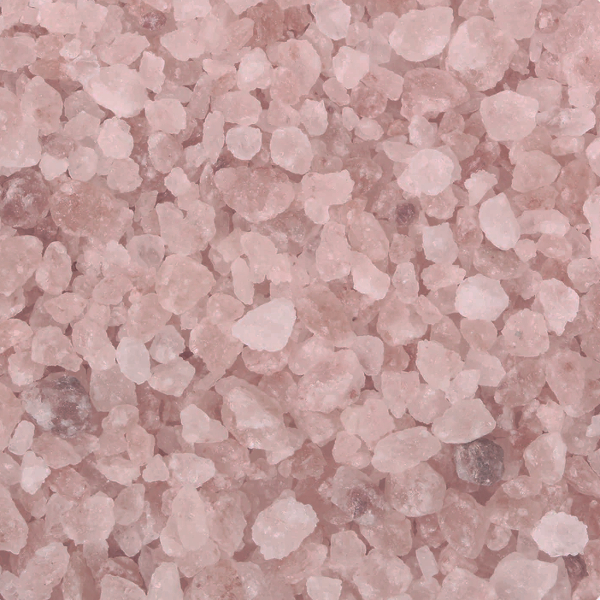
Alpenbergkern Salt:
- A high-iron salt containing 84 minerals, from the Salzkammergut area in the Alps.
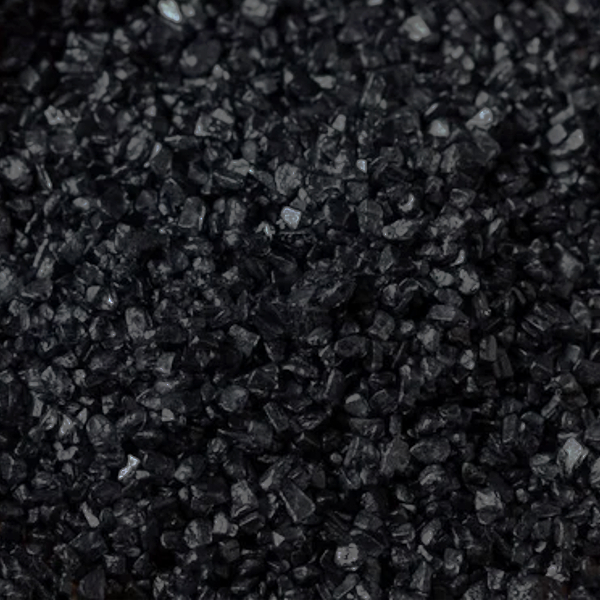
Black Lava Salt:
- Sea salt mixed with activated charcoal, black salt is known for its strong, earthy flavor, from Hawaii.

Celery Salt:
- Salt seasoned with ground celery seeds.

Celtic Gris:
- The grey or 'gris' color comes from Atlantic ocean minerals in the salt, usually harvested from tidepools off the coast of France.
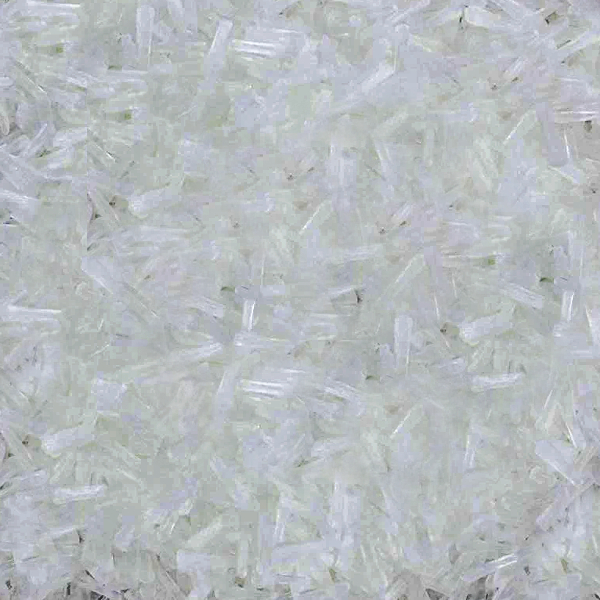
Chinese Salt or MSG:
- "Ajino Moto," or the "essence of taste," is a sodium derived from glutamic acid - naturally found in foods like tomatoes or cheese. Also known as "Hydrolized Yeast," or "Yeast Extract."

Garlic Salt:
- A Popular salt and dried garlic mixture, sometimes containing dried parsley.

Green Salt:
- This plant-based 'salt' is from dehydrated salicornia - also called "sea beans," "sea asparagus," 'pickleweed,' 'glasswort,' 'hamcho,' 'samphire,' or 'queller' - ground into a powder.

Green Tea Salt:
- Salt mixed with unsweetened matcha, or a dried green tea powder.

Grey Flake Salt:
- Also called "Sel Gris," a light, flaky salt with a mineral-rich grey color, good for finishing.

Maras Salt:
- The Peruvian salt deposits of Maras were once part the sea floor, but tectonic activity pushed the seabed up to form the Andes, and the salt now filters out through the Qoripujio spring and into evaporation ponds.

Onion Salt:
- Dried onion mixed with salt, popular for soups and stews.

Popcorn Seasoning:
- Salt mixed with dairy powder and butter flavoring, mostly used for popcorn but popular on vegetables like broccoli and corn.

Rose Salt:
- Salt is dissolved into rosewater and then re-crystallized to into this fragrant, slightly pink rose-flavored salt that is safe to cook with.

Salt Substitute:
- With lower sodium levels, potassium chloride is shown here mixed with green salt - but potassium salts may be harmful if you have high potassium.

Seasoning Salt:
- Any blend of salt, herbs, and spices; commonly including things like onion, garlic, paprika, thyme, or lemon and black pepper. Popular brands include Lawry's and Morton.

Sea Salt & Turbinado:
- A coarse natural light brown sugar similar to "Sugar in the Raw," turbinado is mixed with sea salt, popular for finishing pastries and sweets.

Seaweed Salt or Moshio:
- The Japanese seaweed Sargassum fulvellum or 'hondawara' is dried and then boiled in bags with seawater to form a concentrated brine, further reduced until the moshio salt crystallizes.
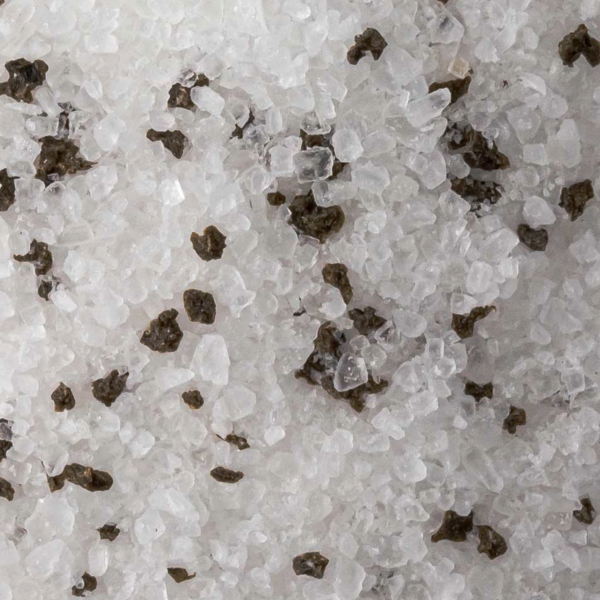
Truffle Salt:
- Any salt that has been flavored with dried truffles, sometimes white but most commonly black.
ARTISINAL SALTS:


Asín Tibuok: A rare artisanal Filipino sea salt from Bohol island, literally translated into "unbroken salt" or "whole salt," and aptly nicknamed "dinosaur egg salt" based on its appearance. Coconut husks are soaked in seawater for six months before being burned into ash. More seawater is poured throught the ash and then boiled in coconut-shaped clay pots in a large furnace. The resulting egg-shaped lump of salt is traditionally kept upside down with the broken clay pot and shaved over food as needed.

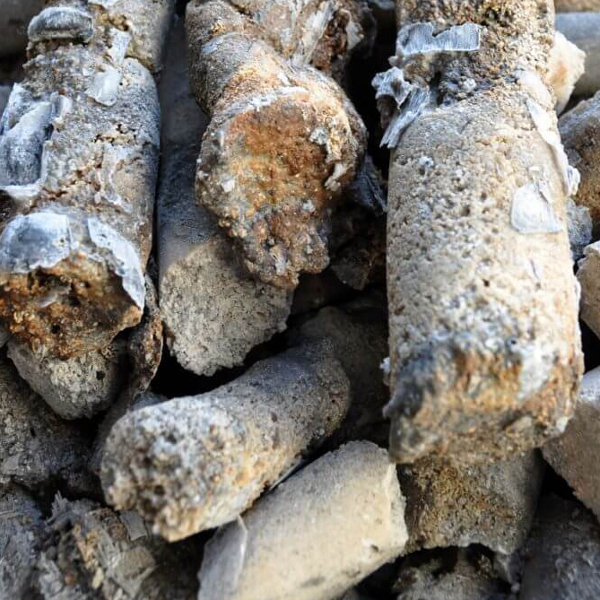
Jukyeom: Also known as "bamboo salt" or "Korean purple salt," Jukyeom is a sea salt that has been roasted in bamboo canisters. Bay salt is packed into a thick bamboo stem sealed with clay and baked in kilns over pine firewood nine times. The bamboo flavors the salt with a distinctive sweetness, called 'gamrojung,' and the high-temperature firing firing processes darken the salt, giving it a unique combination of blue, yellow, red, white and black crystals.

River Reed Salt: This artisinal salt is produced in the village of Nabuyole in Webuye Constituency of Bungoma County, Kenya. The river reeds that grow along the Nzoia River are collected, dried, and then burnt to obtain the ash, which is then placed in a vessel with drainage. Water is slowly poured through and collected in another vessel, filtered to remove impurities and boiled until the salt crystallizes. It is said to have a mellow tangy and sharp taste, traditionally packaged in banana leaves.

Thursday Salt or Black Salt: Traditionally made in Russia on the Maundy Thursday before Easter, rock salt is mixed with ingredients like eggs, flour, rye bread, cabbage leaves, thyme and other herbs. This mixture is wrapped in a linen cloth and baked over birch wood in a 600° oven, forming it into a lump, which is then ground and filtered to remove the ash, leaving 'magical' black salt crystals that smell like bread.


Tutul: A very rare artisinal salt block, locally known also as 'dukduk,' from the Philippines - specifically Hoskyn barangay, in the municipality of Jordan, Guimaras island, Western Visayas. First, an assortment of driftwood and washed-up plant matter from the beach is gathered, called 'dagsa.' These seawater-logged materials are then burned in large quantities and doused with salt water daily in a process that lasts up to a week. After a sizable amount of ashes is created, it's transferred into large woven bamboo cylinders called 'kaing.' Seawater is poured over the kaing several times and collected, filtering the salt from the ashes. The strained water is then mixed with coconut milk or 'gata' and heated in a cooking pan or 'hurnohan' over a slow fire. More strained water is added as the mixture simmers and reduces for at least five hours, until the salt solidifies and all the moisture has evaporated. These brick-like lumps of salt are referred to as 'bareta.'
June, 2019 ONIONS, SHALLOTS + SCALLIONS
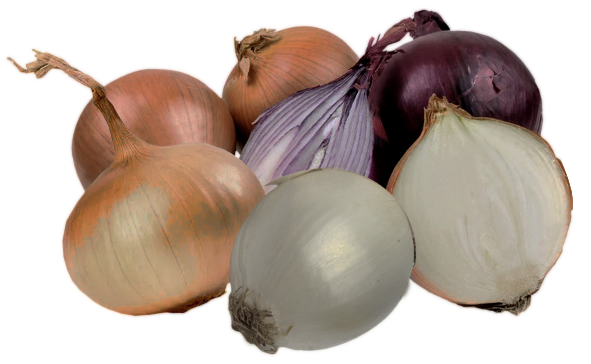
Allium Cepa: From the Amaryllidaceae family, part of the Asparagales (asparagoid lily) order. Also known as the bulb onion, common onions are a cultivated vegetable used in culinary dishes around the world, either served raw or cooked as part of a savory dish, but they may also be pickled. In French cuisine, onions along with celery and carrots make up the basis of 'mirepoix,' and also the "holy trinity" of Cajun cuisine.
Allium Ascalonicum: Technically not viewed as a separate species from onions, shallots are often interchangeable for onion within recipes, but for culinary purposes the two remain distinctly different.
"Onion" derives from the Old French 'oignon,' from the Latin word 'unio.' Cepa is also accepted as Latin for 'onion,' which is closely related to the Ancient Greek "kápia" and the Albanian "qepē," the Aromanian "tseapã," the Catalan and Occitan "ceba," the Portuguese "cebola," the Spanish 'cebolla,' the Italian 'cipolla,' and the Romanian 'ceapă.'

"SHALLOT", or Eschalot is from the French 'échalote' and Old French 'eschalotte,' via 'eschaloigne,' which derives from the Latin Ascalōnia 'caepa' or "Ascalonian onion," based on its cultivation in the medieval city of Ascalon.
Onions have an intense smell with a texture very similar to celery or apples, and a sharp spicy flavor that diminishes to a savory sweetness when cooked. Shallots taste very similar to onions but are milder in flavor, and more reminiscent of a cross between garlic and scallion. Both onions and shallots contain pungent chemicals that irritate the eyes when chopped. Click here to learn more about the different varieties of shallots.

Dehydrated onion powder, dried minced onions, and dried shallot slices are readily available to give your dishes a one-two punch of onion flavor if you don't want to include the texture or potency of onion or if you don't have fresh onion on hand. You can also find pre-fried onion pieces and shallots to give your salads and cooked dishes a flavorful crunch. Finely-sliced deep-fried shallots are commonly found in Asian cuisine, and French-Fried Onions or Onion Rings are both a popular snack and topping in American cuisine.
BULB VARIETIES:
Red:

- Potent smell and flavor, often served raw
- Firmer texture when cooked
- Higher sugar content, good for pickling and grilling
- Reddish-purple color livens up dishes
Yellow:
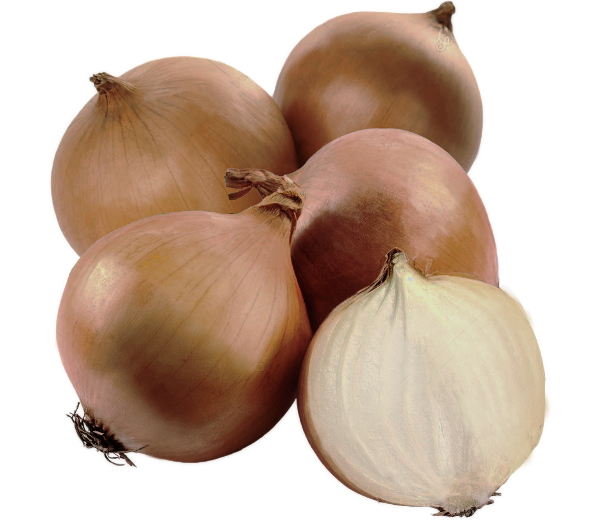
- Most common onion for cooking, usually not served raw
- Higher sulfer content and richer in antioxidants, also called "brown onions"
- Intense smell and taste good for roasting or caramelizing
White:

- The mildest of onion varieties, often used as garnish for salads, sandwiches and the Vietnamese dish Phð
- High water content, best for serving raw or fried as onion rings
- Contains the sub-varieties of "sweet onions"
Sweet:
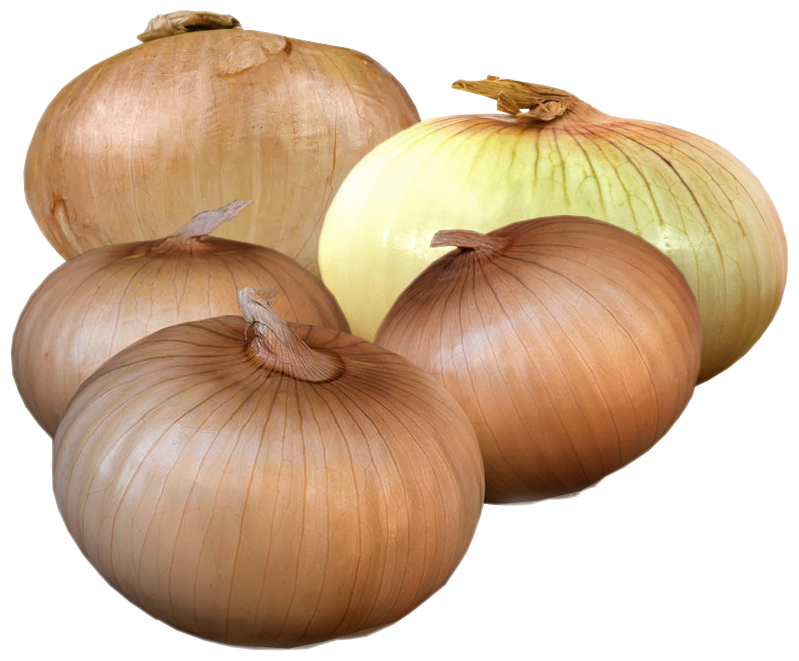
- Specific types include 'Maui,' "Texas Sweet," 'Vidalia,' and "Walla Walla"
- Higher sugar content, the sweetest of onion varieties, not recommended for pickling
- Lower sulfur content with a texture similar to yellow onion
PEARL ONIONS:
Allium Ampeloprasum or Sectivum: Also known as button, baby or silverskin onions; pearl onions may only be distinguishable from regular baby onions by their single storage leaf, similar to garlic. They are referred to in French cuisine as 'oignon grelot,' and the rarer term 'petit poireau antillais,' known for their soft, sweet taste - crucial to the French bistro dish, Coq Au Vin.

Pearl onions are most commonly used for pickling, and are available frozen for soups and stews, etc. White varietals include Crystal Wax, and White Bermuda. Unlike larger onions, the red varieties have a milder flavor. Cocktail onions are usually brine-pickled pearl onions in with a small amount of turmeric and paprika - essential for the popular cocktail, the Gibson Martini.
{ SCALLION, GREEN + SPRING ONIONS }

Allium Fistulosum: The "bunching onion" or "long green onion," also referred to as the "Welsh onion" or the "Japanese bunching onion" is a vegetable and ornamental flower that doesn't form a large bulb, and is used specifically for scallions and only scallions. However, the term 'scallion' can refer to any cepa allium that is used as a vegetable with a small or under-developed bulb. For culinary purposes, scallion often refers to the white part of the allium, and green onion indicates the use of the teret (hollow and tubular) green leaves which are often chopped and used as a garnish. Scallion can be eaten either raw or cooked, with a much milder taste than bulb onions, and red scallion is also available but rare. Scallion, along with ginger and garlic, make up the "holy trinity" of Chinese cuisine.
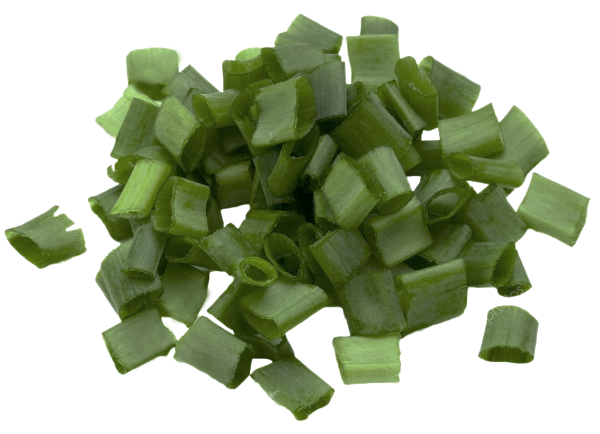
"SCALLION" - or "green onion" and sometimes "spring onion" - is also referred to as "long onion," "table onion," "salad onion," "baby onion," "wild onion," "yard onion," "precious onion," "onion stick," 'gibbon,' 'cebollita' or "little onion" in Spanish,'calçot' in Catalon, 'wakegi' or "tree onion" in Japanese, and the Scot 'syboe.'
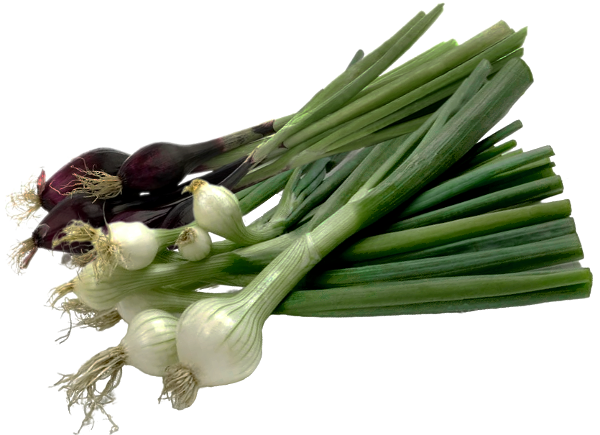
Spring Onions are scallions with slightly larger bulbs, or pearl onions with the leaves still attached, or common under-developed bulb onions depending on the species. They are more similar in size to shallots and milder in flavor than onions, but more intensely flavored than normal scallions.
*Scallions are used in the southern Philippines to make Wet Palapa, a native condiment of ground scallion, ginger and chili pepper, or the dry version which is stir fried with fresh coconut shavings. There is also Korean Haemulpajeon - a seafood and scallion pancake; Irish Champ, which refers to chopped scallion and mashed potatoes; and the Calçotada or Calçotades - a popular gastronomic event where massive amounts of scallions are grilled and dipped in Salvitxada or Romesco sauce.
{ CHINESE ONIONS }
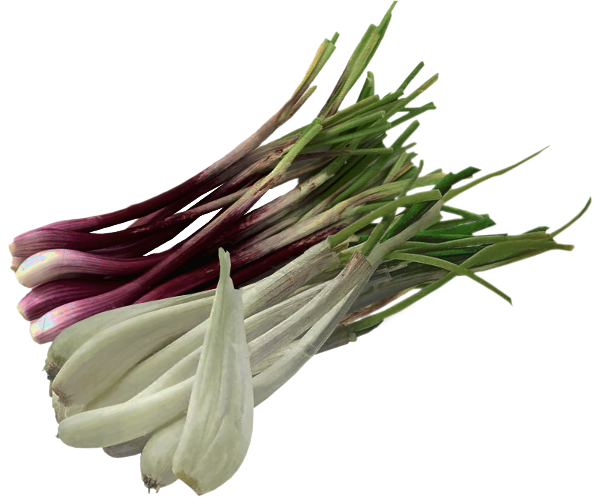
Allium Chinense: Most commonly called Japanese 'rakkyō,' Chinese onions, also known as "Chinese scallions," "glittering chives," "Japanese scallions," "Kiangsi scallions," and "Oriental onions" are Allium vegetables specifically native to China. These are most similar to overgrown scallions with large tubular-shaped bulbs, unlike spring onions or shallots. They are known for having a very mild and "fresh" taste, often pickled and served as a side dish in Japan and Vietnam.
FC CARAMELIZED ONIONS:
I like to keep caramelized onions in the refrigerator for sandwiches, salads, pizza toppings and more. They only keep for about 3-5 days, and they can be frozen in ice-cube trays like eggs and herb mixtures, although the texture softens - but they never last long enough in my kitchen to go bad.
| Choice Onions | : | 1-2 halved + sliced |
|---|
| Vinegar or Wine | : | 2-3 tbsp, to taste |
|---|
| Butter or Oil | : | 1-1½ tbsp |
|---|
| Salt + Seasonings | : | optional, to taste |
|---|
DIRECTIONS:
Saucepan or Heavy-Bottom Skillet- heat pan to HOT. Use a small portion of butter or oil if using stainless steel. Add sliced onion and shake to keep from sticking - stir frequently.
Lightly Scorch- onion to begin the browning process. Add the rest of your butter or oil, season to taste and reduce heat to medium-high, continuing to stir for 2-3 minutes.
Deglaze- with vinegar or cooking wine and reduce heat to a low simmer. Continue to stir frequently until the liquid is reduced, the onion is translucent, and the desired firmness has been achieved.
May, 2019 PERFECTION IN BROILING - Broccoli
Brassica Oleracea: From the Brassiceae family, part of the Brassicales (mustard) order. A cruciferous vegetable with large dark green flowering heads, branching out from a thick light green stalk like a tree, surrounded by leaves, which eventually blooms to small yellow four-petal flowers. 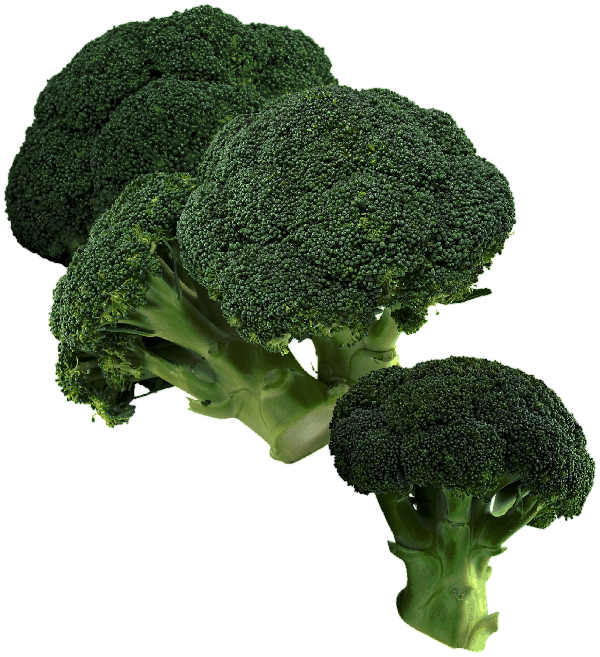 Broccoli is visually similar to but very different from the closely related cauliflower. Broccoli can be eaten either raw or cooked, and is a rich source of the vitamins C and K. Broccoli was developed from wild cabbage, like all other brassicas; specifically colewort, or field cabbage around the sixth century BC. Broccoli has its primitive origins in the Roman Empire, and by the 18th century was spread to northern Europe, later brought to North America by Italian immigrants in the 19th century. After the Second World War, several varieties were cultivated, including 'Premium Crop,' "Packman," and "Marathon." Violet, yellow and white varieties of broccoli have also been created, but they are very rare.
Broccoli is visually similar to but very different from the closely related cauliflower. Broccoli can be eaten either raw or cooked, and is a rich source of the vitamins C and K. Broccoli was developed from wild cabbage, like all other brassicas; specifically colewort, or field cabbage around the sixth century BC. Broccoli has its primitive origins in the Roman Empire, and by the 18th century was spread to northern Europe, later brought to North America by Italian immigrants in the 19th century. After the Second World War, several varieties were cultivated, including 'Premium Crop,' "Packman," and "Marathon." Violet, yellow and white varieties of broccoli have also been created, but they are very rare.
"BROCCOLI" originated in the 17th century from the Italian plural of 'broccolo,' or "flowering crest of cabbage," which is the diminutive form of 'brocco,' translating to "small nail" or 'sprout.'
FC BROCCOLI:
| Broccoli | : | 1 large head, or
2-3 cups of florets |
|---|
| Butter | : | 1-2 tbsp, to taste |
|---|
| Olive Oil | : | 1 tbsp, to taste |
|---|
| Lemon Juice | : | 1-2 tbsp, to taste |
|---|
| Lemon Zest | : | ½-1 tsp, grated |
|---|
| Salt | : | 2 small pinches, to taste |
|---|
DIRECTIONS:
Large Pot- blanch broccoli in boiling water for 1 minute or so, strain and quickly chill in ice bath - (optional step)
Small Microwave Safe Dish- Melt butter with lemon zest for 25 seconds. Mix with olive oil, lemon juice, and salt.
Baking Sheet- Preaheat the broiler, toss all ingredients together and spread out evenly on baking sheet.
Broil- on the middle rack for 10-15 minutes or until desired tenderness is achieved, flipping the broccoli over after about 6–7 minutes. You may want to move the broccoli to the top rack for the last few minutes to brown slightly. NOTE: This is a great recipe for steamed broccoli also - I usually add my used lemon to the boiling water.
April, 2019 NIGELLA, ONION SEED + PANCH PHORON
After last month's post I figured I'd finish it up with a couple more seeds that are commonly confused in recipes. These black seeds are obviously not part of the cumin family, but Nigella is often referred to as "black cumin" for the way it tastes, so it's good to know the difference!
{ NIGELLA }

Nigella Sativa: From the Ranunculaceae family, part of the Ranunculales (buttercup) order. Pungent seeds, used as a culinary spice and in herbal medicine, nigella is one of the oldest cultivated seeds known to mankind - believed to have been discovered in the 3,000 year old tomb of Tutankhamun. The Bible mentions nigella seeds in the Old Testament, and the Prophet Muhammad supposedly spoke highly of their health properties. Asian herbalists and pharmacists have used nigella seeds since antiquity, and the Romans further documented its culinary purpose. The seeds are also known to repel certain insects just as moth balls do. Referred to as 'black seed,' nigella is also called "black caraway" and "black cumin," 'damascena,' 'devil-in-the-bush,' "fennel flower," 'melanthion,' "nutmeg flower," "Roman coriander," and "wild onion seed." Nigella seeds are similar to onion seeds, with a matte dark charcoal color, roughly triangulate with an oily white interior; but they are smaller and more flavorful, tasting of cumin and pepper.

"NIGELLA" is from the Latin 'nigellus' or 'niger,' in reference to the black seed color. They are called "cheveux de Venus," 'nigell,' or 'poivrette' in French; 'Kalonji' in Hindi, and 'neguilla' in Spanish.
Nigella seeds are packed with antioxidants that can protect against diseases like cancer and diabetes, helping to regulate blood sugar levels and protecting the liver from damage, particularly effective at reducing cholesterol. They have also been associated with reduced inflammation, and in Northern Africa nigella seeds have been used since ancient times to treat fevers, coughs, headaches, influenza and asthma; even eczema.

With a flavor similar to cumin that can range from bitter and smokey to nutty with nuances of citrus, nigella seeds taste faintly of oregano and black pepper, reminiscent of burnt onion, sesame seeds, or poppy seeds. They provide an excellent crunch to soft, chewy foods, and they are often used to season naan breads. Nigella seeds are sometimes mistaken for cumin or caraway seeds based on their common names, black onion seeds based on their appearance, or even black sesame seeds at a glance. A common ingredient in Indian, North African, and Middle Eastern recipes, nigella is commonly used to garnish curries, rice or lentil-based dishes; in stir-fries and pickling, or to season vegetables; in addition to being a popular flatbread topping.
NOTE: Nigella yields a volatile oil containing melanthin, which is toxic in large dosages; and niugelline, a paralytic - so this spice must be used in moderation, much like alcohol.
{ ONION SEED }
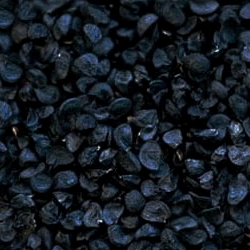
Many varieties of onions produce black coloured seeds, and these are sometimes confused with the black seeds of Nigella sativa. In fact, nigella is referred to as onion seed in advertisements. Although similar in appearance, they are not identical, and the best way to identify them is their shape. Upon close inspection, onion seeds are flatter and papery-looking, as if they're dehydrated and much less full than nigella. Also, onion seeds are mostly flavorless - if you happen to purchase a spice labelled as "onion seed," it's most likely Nigella sativa.
{ PANCH PHORON }

The five-ingredient Bengali spice blend, "Panch Phoron" includes nigella along with fennel, cumin, methti, and mustard seeds - an essential mixture for several dishes from India and Bangladesh. A whole spice blend originating from Eastern India, Panch Phoran is also known as "panch phoran," "panch phodan," "pancha phutana," "panch masala," "padkaune masala" and "Indian Five Spice" - where 'panch' means 'five' and 'phoron' means 'tempering.' In my recipe here, I've deviated from the traditional recipe and omitted most of the methti or fenugreek seeds, replacing them with poppy seeds and white poppy seeds. Also, some recipes called for mustard seed and others called for celery seed so I've put both in here. Now it's eight spices and calling it a five-spice is strange but you don't have to feel bad if you're missing a few spices and you just omit them.
FC EIGHT SPICE PHORON:
| Mustard Seed | : | 1 part Rai Kuria or Black |
|---|
| White Cumin | : | 1 part whole |
|---|
| Fennel Seed | : | 1 part whole |
|---|
| Nigella | : | 1 part whole |
|---|
| Celery Seed or Radhuni | : | ½ part whole |
|---|
| Poppy Seed | : | ½ part whole |
|---|
| White Poppy Seed | : | ½ part whole |
|---|
| Methti | : | ¼ part ground, to taste |
|---|
Typically, before panch phoron is used it's toasted and bloomed in oil or ghee (clarified butter). This is a very potent spice blend, so it's recommended that you do not use it with garlic, onions, ginger, or shallots. Mix it up and keep it on hand for dhals, lentils and vegetable curries, or grind it up and use it as an interesting dry rub for poultry and meats.
March, 2019 CUMIN, FENNEL SEED, ANISE SEED, AJWAIN + CARAWAY
Oh my! These seed varieties are sometimes mistaken for each other and luckily, are somewhat interchangeable within recipes. Hopefully this helps you differentiate them for your culinary prowess.
{ CUMIN }

Cuminum Cyminum: From the Apiaceae family, part of the Apiales (umbellifer) order. Originating in Tukey and Syria, cumin seed - with its distinctive flavor and aroma - has been used in the cuisines of many cultures as a spice, in both whole and ground form, for millenia. In the now-submerged Atlit-Yam, a settlement from early 6th millennium BC, wild cumin seeds were excavated; as well as several New Kingdom ancient Egyptian archaeological sites, where cumin was not only a spice, but a preservative in mummification. During the Late Minoan period in ancient Crete, ideograms appeared on tablets documenting the cumin available at Minoan palace stores; and the ancient Greeks are said to have kept cumin at the dining table - as pepper is today - a practice that continues in Morocco. Cumin has been used most predominently in India, as both the basis for many recipes, curries and spice blends, and an ingredient in traditional and Ayervedic medicine. The ancient Romans used cumin significantly also, and it was the Spanish and Portuguese colonists that introduced the spice to the Americas. In Indonesia, both cumin and caraway are called 'jinten,' and many European and Asian languages have no clear defined distinguishment between the two, whereas it's referred to as "spice caraway" or "Roman caraway" in many Slavic and Uralic languages. Cumin is commonly confused with caraway based on its appearance - but cumin has a unique, powerful flavor that is unmistakably different.

"CUMIN" is the Middle English and Old French term derived from the Latin 'cuminum,' from the Ancient Greek 'kúminon,' which is related to the Hebrew 'kammōn' and the Arabic 'kammūn;' ultimately derived from the Akkadian 'kamūnu.'
Although there is no scientific proof that Cumin is a safe or effective therapeutic agent, it is a rich source of iron said to promote digestion. It has also been used to treat chronic diarrhea and dyspepsia, containing beneficial plant compounds that may help lower blood sugar, improve cholesterol, stimulate metabolism, inhibit bacteria growth in food, and fight inflammation. Cumin provides high amounts of monounsaturated fat, protein, and dietary fiber; with substantial amounts of vitamins B and E, including the minerals magnesium and manganese.

Cumin is mostly used in savory dishes such as chili and curry, stews and soups, often in pickling and in some pastries, like traditional breads from France; with an earthy and slightly bitter, slightly sweet flavor described as warming and nutty with a touch of citrus. The unique flavor and aroma of cumin elevates the taste of recipes, and roasting or toasting the seeds richens the flavor, which is further intensified when ground. Cumin is used as a flavorant in some cheeses, such as Leyden, as well as many other commercial food products. Cumin is most notably used along with chili powder in Tex-Mex or Mexican-style taco seasoning, in achiote, adobos, sofrito, bahaarat, dhana jeera, garam masala, and curry blends for Hispanic, Indian and other South Asian cuisines.
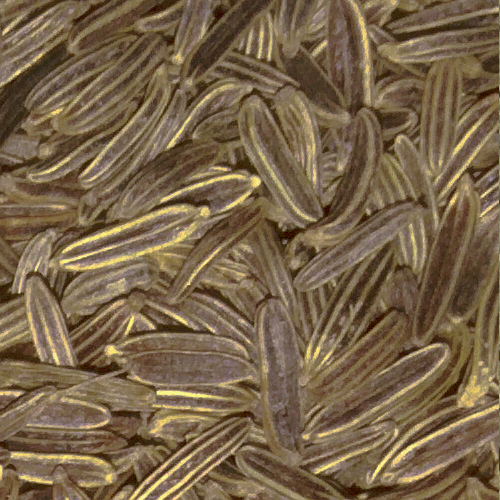 Standard Cumin 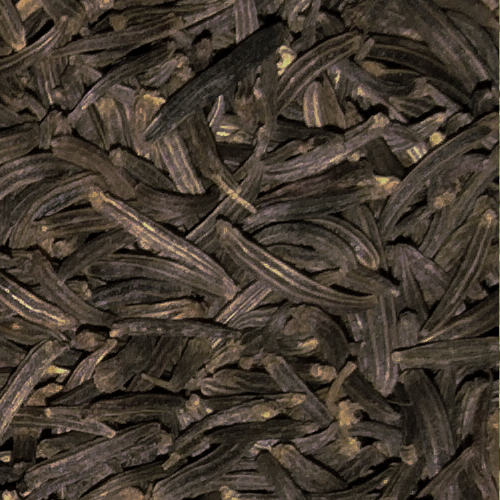 Black Cumin Cumin seeds have an oblong shape with eight ridges formed by oil canals around the the seed casing. The most common type of cumin seed is usually a yellow-brown color, but there are several other varieties available, the most distinguishable of which is black cumin.
BLACK CUMIN:
Elwendia Persica,Bunium Bulbocastanum, Bunium Persicum, Carum Heterophyllum, Carum Persicum, Pimpinella Cyminosma, or Sium Cyminosma are culinary spices closely related to cumin, also referred to as 'black cumin,' "blackseed," or 'black caraway.' These are often confused in recipes with Nigella, which is nicknamed "black cumin" for the way it tastes, but they are remarkably different in appearance. Black cumin seeds are much smaller and thinner than regular cumin, with a slight curve in shape; and they differ dramatically in color - darker and blackish brown. Black cumin is usually used whole in cooking because its flavor noticably diminishes when ground, and this particular variety of cumin is often viewed as an indication of high-value or specialty dishes.
"BLACK CUMIN", or 'scharzkümmel' in German goes by many other names. "Kala jeera," or "kala zeera" in Indian, "syah zirah" or "mountain cumin" in Urdu, "kalo zeera" in Bengali, "siyoh dona" or "black seed" in Tajiki, and 'sahajīrakam' in Malayalam. 'Syahi' means "inky black" in Hindustani, 'syahi' means black in Persian, and 'siyah' means black in both Persian and Urdu, so "siyah jeera" or "syah zirah" are used in both languages.
More suitably replaced with nigella or a tiny bit of green pepper, the flavor of black cumin is less bitter than white cumin, a bit sweeter and reminiscent of oregano, black pepper, and onion with hints of lemon.
OTHER CUMIN VARIETIES:
White Cumin: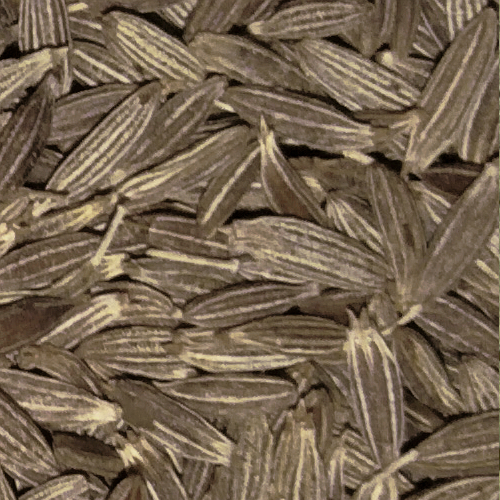
- Pale yellow-brown surface color, just slightly lighter than standard cumin and a bit fuller in shape - also called "zireh kuhi" or "wild cumin" in Persian.
- Higher in oil content, popular for Ayervedic cooking, thought to have antioxidant and anti-cancer properties
- Most similar in taste to standard cumin but more bitter - warm and earthy, with tart undertones
Brown or Bitter Cumin: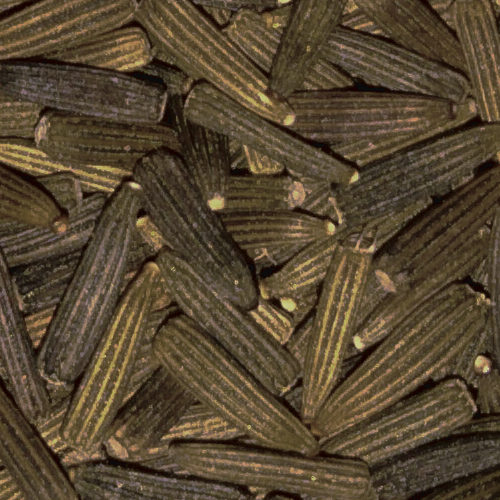
- Cuminum Nigrum, also called or "kaala zeera" in Indian, and "kaala zirah" in Urdu; used in North African, Indian, and Mexican cuisines
- Similar in color to black cumin, but much larger and wider in girth
- Most bitter of cumins, earthy, and peppery with sour overtones - reminiscent of bitter melon.
Green Cumin:
- Smaller, under-ripe fennel seed, also called "zireh sabz" in Persian, or "veena kala jeera" and "jeera kala asli" in Indian
- Pale green to dark green coloration, used to soothe the digestive tract and stimulate appetite
- A slight licorice taste like regular fennel seed but much more bitter, lacking in size and sweetness - sometimes labelled as "lakhnavi sonf" instead of 'saunf.'
- Popular in traditional North Indian and Persian dishes, closely related to Mughal/Moghul cuisine and Kashmiri gastronomy
- ¾ Fennel Seed and ¼ Brown or Bitter Cumin is a suitable substitution for green cumin
{ FENNEL SEED }

Foeniculum Vulgare: Also called 'saunf,' 'samf,' 'madhurika,' or 'shatapushpa' - and often confused with anise seed and basically identical to green cumin - the well-ripened seed of the fennel plant has been a popular culinary herb throughout history, popular as a flavorant for curries, sausages, seafood and sauces, as well as one of the spices used in Pickling, Chinese Five Spice and Indian Panch Phoron. Fennel seeds are also commonly used to flavor breads, cakes, and cookies, with a structural appearance similar to cumin, but green, with a distinctive warm, sweet aroma and an earthy herbaceous taste similar to licorice root or anise seed, but less pungent. Foeniculum vulgare is also cultivated as a vegetable - click here for more information on fennel bulbs and frond. Fennel seeds are rich in potassium, helping to regulate fluid levels in the bloodstream, and a good source of vitamins, minerals, and fiber; with iron, calcium, magnesium, and manganese. They help control heart rate and blood pressure by increasing nitrite levels in saliva, and are known to support healthy digestion, traditionally used to relieve occasional gas and bloating in digestifs and taken as digestives.
*Green cumin can obviously be used as a substitute for fennel seed, or vice versa - countering the bitterness by either adding a sweetener, or using a combination of green cumin and anise seed. Anise seed alone is also an excellent alternative but you will want to use approximately half the amount of anise, since it has a stronger flavor. Tarragon, licorice root and dill or caraway seeds may also be used, depending on the application.
{ AJWAIN }

Trachyspermum Ammi: Also known as 'carom' or "carom seeds," "ajowan caraway," "thymol seeds," 'omam' in Tamil, or ambiguously referred to as "thyme seeds" and "bishop's weed;" ajwain's seed-like fruits or schizocarps are used a spice and its feather-like leaves are edible as well. Ajwain's seed-fruits contain thymol, which makes them smell and taste like thyme, but they are more pungent and bitter with hints of mint, anise and oregano. The seeds are sometimes confused with the rare, celery seed-like spice, lovage seed, although the flavor difference is unmistakable.
Ajwain is often used in traditional medicine, with active enzymes that improve the flow of stomach acids, relieving indigestion, bloating, and gas; and can also help treat peptic ulcers.
Ajwain is commonly toasted or fried in ghee (clarified butter) or oil as part of the tadka (tempering cooking method) in small quantities, and is rarely eaten raw due to its strong flavor and bitterness. it is used in chaunk or tarka (spice mixtures), teas, soups, dals and curries, sprinkled over breads and biscuits, or incorporated into naans, parathas and pakoras. Ajwain is also used to flavor meat and rice dishes, and as a preservative in chutneys, pickles, and jams. Powdered carom should be pre-toasted before ground, and if necessary a suitable substitute for ajwain would be a combination of thyme, oregano, mint, and cumin.
{ ANISE SEED }
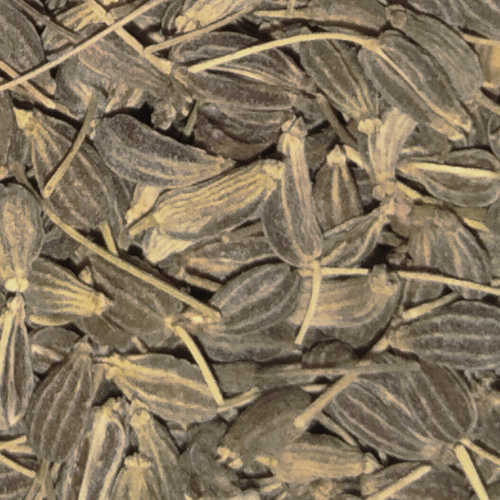
Pimpinella Anisum: Also called 'aniseed' and sometimes 'anix,' anise seeds have similarities with many other seed spices, and are often confused with star anise, although this is another plant entirely. The flavor of anise seed is similar to fennel, licorice, and tarragon - used to flavor ethnic dishes, teas, candy, confections, and processed meat products, as well as liquors and liqueurs. Cultivated approximately 4,000 years ago in Egypt and the Middle East, anise was brought to Europe for its medicinal value. Ancient Romans often served Mustaceoe - spiced cakes with anise seed - at the end of feasts to aid in digestion, and this tradition would later serve as the basis for serving cake at wedding receptions. The freshly chopped leaves can be used in cheese spreads, dips or salads; and the roots and stems can impart a milder licorice-like flavor to soups and stews.
"ANISE" is from the Latin 'anīsum' or 'anēthum,' from the Greek 'ánēthon' or 'dill;' derived via Old French and the Old English 'anet.'
Anise-Flavored Alcohols: Interestingly, some of these liquors are clear but become cloudy when water is added - known as the "Ouzo Effect."
- Absinthe
- Aguardiente
- Anís
- Anis De Chinchón
- Anísado
- Anisette
- Anisette Cristal
- Arak
- Herbs de Majorca
Other Anise-Flavored Treats From Around the World:
Anisbögen,
Anise Biscotti,
Anise Pizelle,
Aniseed Balls,
Aniseed Twists,
Aniseed Wheels,
Atole de Anís,
Bizcochitos,
Black Jelly Beans,
Champurrado,
Humbugs,
Muisjes,
Picarones,
Pfeffernüsse,
Springerle,
and
"Troach" Drops.
{ CARAWAY }

Carum Carvi: From the Apiaceae family, part of the Apiales (umbellifer) order. A spice 'seed' also referred to as "meridian fennel" or "Persian cumin," or caraway fruits are similar looking to cumin seeds - oblong in shape and longitudinally ridged. Both are yellow-brown in color, but cumin seeds have paler ridges. In general, caraway seeds are darker, shorter, smaller, and harder. Caraway is smooth and crescent-shaped, with five ridges, unlike cumin's eight ridges. Caraway tastes of dill, anise or licorice and citrus, more complex, and is also much milder and less pungent than cumin. According to the early Greek botanist Pedanius Dioscorides, caraway was both a herb and tonic; later cited in a Roman Apicius recipe as an ingredient, and historically known to be cultivated in Morocco. Caraway seeds are rich in protein, vitamins B and C, and the minerals iron, phosphorus, and zinc; its leaves are sometimes consumed as herbs similar to parsley, and the root is similar to parsnip.
"CARAWAY" and the Arabic "karawiya" most likely derive from the Latin 'cuminum,' the same as cumin, and the Greek 'karon;' adapted into Latin as 'carum' and related to the Sanskrit 'karavi,' which is sometimes translated as 'caraway' but literally translated as 'fennel.' Also called "Krishna jeeraka" and 'krishnajiraka,' "shah jeera," "shahi jeera" or "royal cumin" in Indian, and "shahi zeera" or "imperial cumin" in Hindi.
Caraway is more common in German cuisine than cumin and typically used whole rather than ground. The most common use for caraway is rye bread and soda bread, but it's also used to flavor cheeses, sauerkraut, and root vegetable dishes - sometimes found in desserts, liquors and liqueurs, beauty products, folk medicines, and even breath fresheners. Although cooking them softens them somewhat, caraway seeds can be much harder than cumin, and it's recommended that you slightly crush them to help release their flavor. Half the amount of caraway is a decent alternative for cumin, but a combination of dill seed and green cumin, or black cumin and fennel seed would be a better substitute for caraway. You could also use a third of the amount in anise seeds.
FC CONFUSING SYRUP:
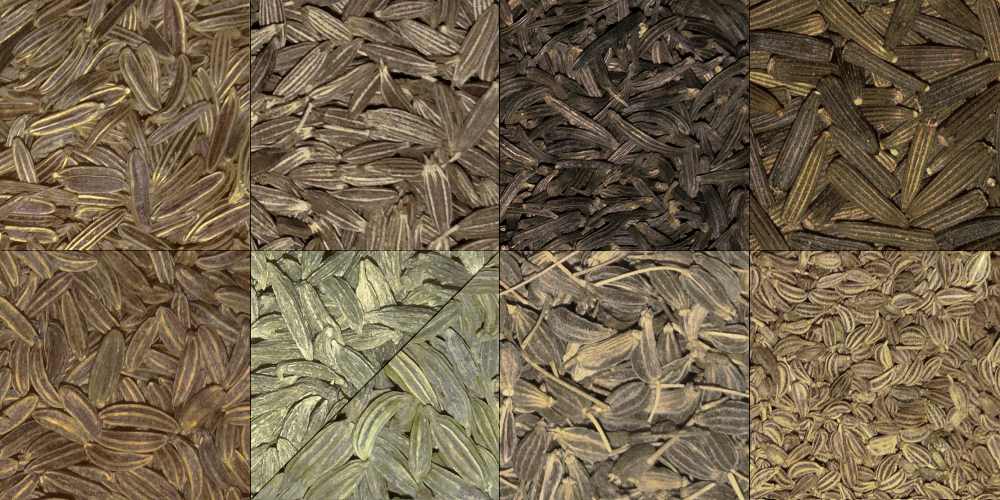
A 'complex' syrup infused with anise seeds, fennel seeds, five types of cumin, caraway, and ajwain that can be used to flavor cocktails and sweeten teas or seltzers. This is a great way to use up old seeds that have been in your spice cabinet for years. I use this syrup mixed with a small amount of coconut oil on pancakes and waffles. A little bit goes a long way!
| Warm Water | : | 1½ cup |
|---|
| Sugar | : | 1½ cup |
|---|
| Anise Seed | : | 2 tbsp whole |
|---|
| Fennel Seed | : | 2 tbsp whole |
|---|
| Caraway | : | 1 tbsp whole |
|---|
| Brown or Bitter Cumin | : | 1 tbsp whole |
|---|
| Green Cumin | : | 1 tbsp whole |
|---|
| Vanilla or Vanillin | : | 1½ tsp or 1tbsp |
|---|
| Ajwain | : | 1 tsp whole |
|---|
| Cumin | : | 1 tsp whole |
|---|
| Black Cumin | : | 1 tsp whole |
|---|
| White Cumin | : | 1 tsp whole |
|---|
DIRECTIONS:
Mortar & Pestle- gently crush the seeds very slightly but do not pulzerize or powder.
Small Saucepan- toast the seeds on medium-high for 1 minutes or so, stirring constantly, careful not to overheat.
Add Sugar- to saucepan and stir to combine with spices, add warm water, stirring constantly.
Reduce Heat- and simmer for 10 minutes, stirring occasionally. Use a spatula to keep the seeds from sticking to the sides of the saucepan.
Fine Mesh Sieve or Cheesecloth- strain the simple syrup mixture and add the vanilla extract.
Glass Decanter- pour mixture into decanter and let cool to room temperature before storing in the refrigerator.
*For an eggless Eggnog-type drink, add a half teaspoon or so to a half cup of half & half. No Brandy necessary! Add a small pinch of fine ground kala namak for that eggy flavor, thicken it with some psyllium powder or clear soluble fiber and throw a dash of Pumpkin Pie Spice on top if you're feeling nostalgic. I like to mix my Confusing Syrup with carrot or pineapple juice for a unique spiced flavor. Blend it into a caramel desert sauce and pour it over ice cream, or make a spiced buttercream frosting for your favorite cupcakes. I made a spiced butter and spread it all over my grandma's famous Banana Walnut Bread - boy, was my grandma confused!
February, 2019 PERFECTION IN BROILING - Potatoes

Solanum Tuberosum: From the Solanaceae family, part of the Solanales (nightshade) order. A starchy root vegetable, potatoes are 'loveable' tubers viewed as a staple food in many cultures. Originally potatoes were discovered and cultivated in the Americas, introduced to Europe by the Spanish in the latter part of the 16th century. There are over 5,000 different potato varieties, with 3,000 coming from Peru, Bolivia, Ecuador, Chile, and Colombia. Most potatoes grown in North America are cultivated in Idaho, click here for more information on potato varieties. Potatoes are rarely eaten raw due to the toxic compounds or glycoalkaloids in the green sprouts and skin, mainly solanine and chaconine. Raw potato starch is also hard to digest, but dried and cooked properly, it can be used as a thickener or binder for soups and sauces - even an adhesive! The alcohols Vodka, Poitín, and Akvavit all come from the fermentaion of potatoes, and potatoes that are too small or blemished are used as feed for livestock, called 'livestock-grade' or 'chats' in some dialects.
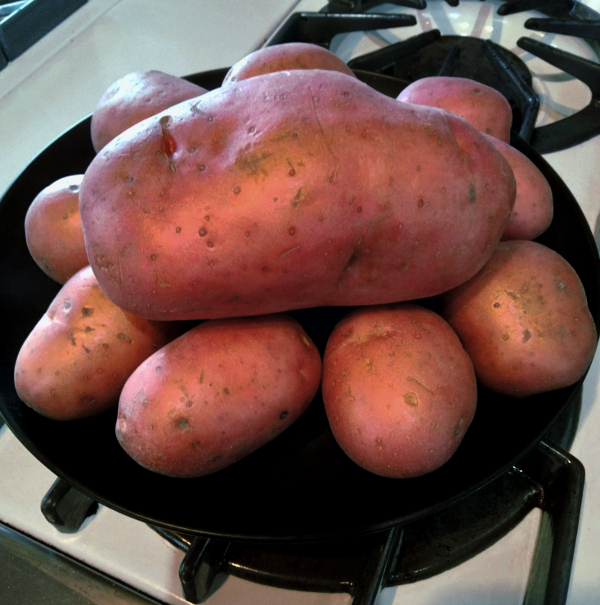
"POTATO" comes from the Spanish 'patata,' a hybrid of 'batata' or "sweet potato" in Taíno and 'papa' or 'potato' in Quechua; originally referring to sweet potatoes as "common potatoes," which were more prevalent. Savory potatoes were referred to as "bastard potatoes" and "Virginia potatoes," and are still occasionally referred to as "Irish potatoes" or "white potatoes" in order to distinguish them. Many languages use a term for 'potato' that roughly translates (sometimes literally) into "earth apple" or "ground apple." The potato nickname 'spud' comes from the potato-planting method, and the usage of a short knife or dagger to dig a hole, rooted in the Spanish 'espada,' the English 'spade' and 'spadroon,' as well as the sprouting process of the tuber itself.
In general, potatoes are categorized into groups based on common characteristics, mostly distinguishable by skin color. The texture of potatoes plays an important role also, and determining which type of potato is best for a certain preparation method is usually based on the starch content versus moisture level; or whether the potato is 'starchy' or 'waxy.' If the potato is somewhere in-between, congratulations - you have yourself an 'all-rounder.'
'Starchy' potatoes, like Russets, contain the glucans amylose and amylopectin with a higher starch content. This makes them fluffier and they can fall apart when cooked - so they are better for mashed and baked potatoes, chips and fries. 'Waxy' potatoes, like Red or Yukon Gold, have a higher moisture level with firmer flesh, lacking the glucan amylose and mostly comprised of amylopectin. These potatoes hold their shape better when cooked - good for roasting, sautéing, and adding to soups and stews. POPULAR POTATO VARIETIES:
Russet:
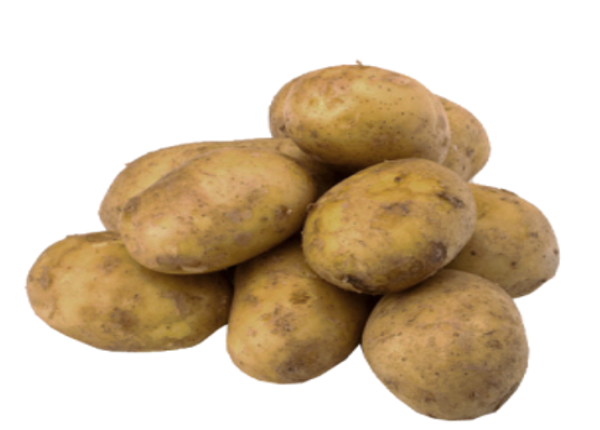
- White inside with a thick skin, usually brown
- Usually starchy, soft and fluffy after cooking
- Often used for baked potatoes and french fries
- Includes the cultivars Russet Norkotah and Russet Burbank
Red:
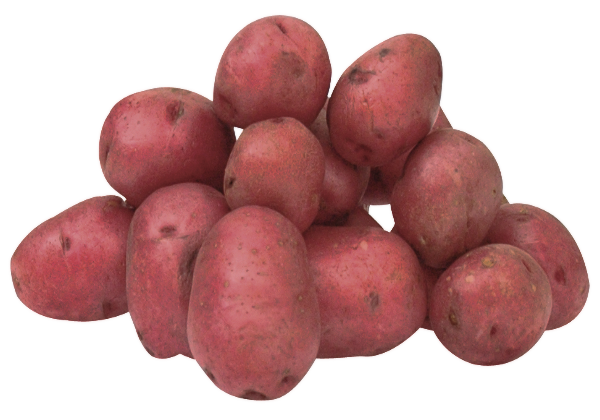
- Thin red skin and white flesh
- Usually waxy with a firm texture when cooked - great for sliced preparations
- Includes the cultivars Désirée, Laura, Red La Soda, and Red Norland
Yukon:

- Thin speckled gold to light brown skin and yellow flesh
- Creamy texture and buttery flavor when cooked
- Good all-rounders, although some varieties are semi-sweet
Blue & Purple:
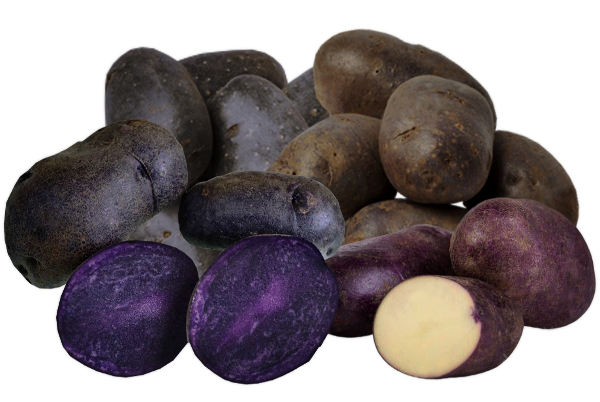
- Blue or purple skin with purple to white flesh, usually all-rounders
- Contain anthocyanin polyphenols, which cause the unusual coloration
- Includes the cultivars Blue Congo and Vitelotte
- Adding lemon juice brightens the purple hue to a deep magenta
Fingerling:

- Thin skin, prized for their long, thin finger-like appearance
- Firmer texture when cooked - often boiled, pan-fried, or roasted
- Includes the cultivars French Fingerling and Purple Peruvian Fingerling
Baby or Marble:

- Thin and delicate skin with a characteristically sweet taste
- Smaller potatoes, harvested before they reach full size - often available in a tri-color medley or mixed bag
- Also known as "new potatoes," "petite potatoes," "roasting potatoes," or 'roasters'
FC BROILER FRIES:
| Small-Med. Potatoes | : | 4-5 cut into wedge fries |
|---|
| Olive Oil | : | 1 tbsp, to taste |
|---|
| Butter | : | 1 tbsp melted, to taste |
|---|
| Choice Salt | : | ¼ tsp, to taste |
|---|
| FC Season-All | : | ¼ tsp, to taste |
|---|
DIRECTIONS:
Preheat Broiler- toss potatoes, oil, butter, and spice mixture together in mixing bowl.
Non-Stick Sheetpan- spread potatoes out evenly, turning the wedges so the skin side is down.
Broil- on the middle rack for 12-15 minutes, until the desired tenderness is achieved. If potatoes brown too quickly, move them to the lower rack.
Taste- and season potates with more salt and spices if necessary.
January, 2019 SUMAC + BENEDICT SEASONING
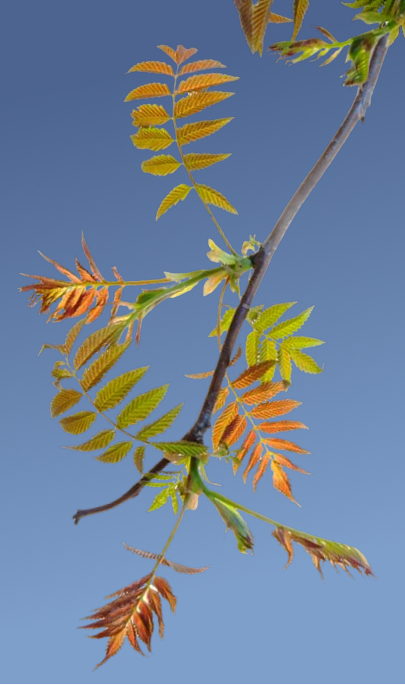
Rhus Coriaria, et al: About 35 specia from the Anacardiaceae family, part of the Sapindales (cashew) order. With high amounts of malic acid and ascorbic acid, sumac is a tangy, reddish purple fruit harvested from the dioecious shrubs and small trees of the same name. The fruits or drupes can be ground into a tart crimson powder that can be used as a spice and combined with other parts of the plant it can be used as 'kōrozen,' a powerful purple dye rich in tannins for leather tanning. In the 13th to 15th centuries, 'sumāqiyya' or 'somacchia' appeared frequently in cookbooks, an affluential stew made from sumac by Europeans, and in medieval medicine, sumac was thought to have many beneficial properties, and a more recent clinical study has shown that sumac can decrease blood pressure related to hypertension. Sumac is commonly used to make a traditional "pink lemonade," 'sumac-ade,' "Indian lemonade," or "rhus juice" by steeping the fruits in cool water, rubbing the fruits and straining them through a cheesecloth to remove external hairs and sometimes adding sweeteners.

"SUMAC" is from 13th century Old French, derived from the Mediaeval Latin 'sumach,' from the Arabic 'summāq,' and from the Syriac 'summāqa' - meaning 'red.' 'Rhus' derives from the Ancient Greek 'rhous' - meaning 'sumac' and possibly connected with the verb 'rheō' or "to flow."
In Arabian cuisine, sumac powder is used as a garnish for meze or small appetizes plates like Hummus and Tahini or Tashi, and often added to Falafel. In Syrian cuisine, sumac is the basis for Kubah Sumakieh and the Palestinian dish Musakhan. Sumac is commonly added to rice, Kebabs, Salads, and Lahmajoun or Armenian Pizza.
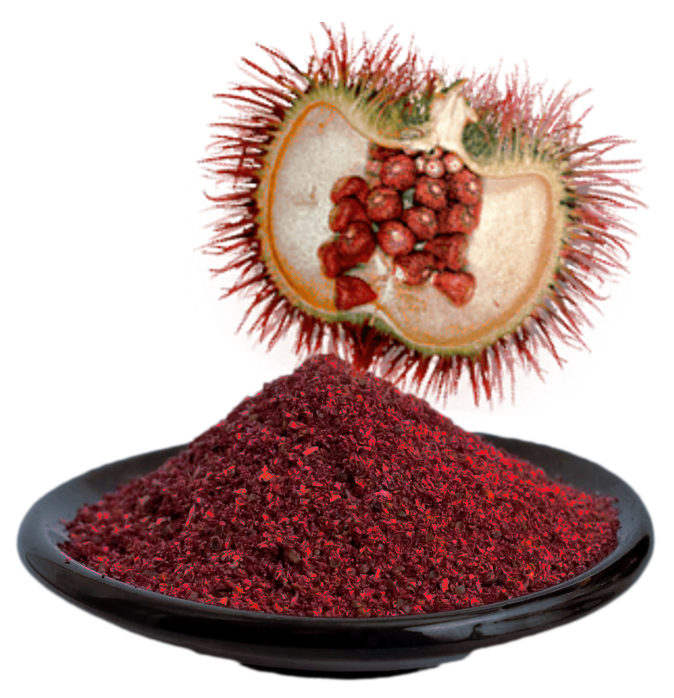
One of my favorite uses for sumac is to season my eggs, particularly Eggs Benedict. Traditionally, the Hollandaise has cayenne pepper in it, so a little more is sprinkled on top. Some people use paprika, since it's less spicy, but I like to use this spice blend.
FC BENEDICT SEASONING:
| Paprika | : | 1 tbsp |
|---|
| Cayenne | : | ¼ tsp, optional |
|---|
Simply pulse all ingredients together in a spice grinder or mortar and pestle until they are well-blended and store in an air-tight glass decanter.
NOTE: Other seasonings I like to use for Eggs Benedict are some fresh chopped chives on top and a little bit kala namak on the eggs themselves to really maximize that eggy flavor.
|
















 The ancient Romans regarded leeks as superior to garlic and onions, and Apicius, a cookbook from 1st century CE contains four recipes including leeks. Nero, the Roman emperor often credited with the fall of the Roman Empire, consumed such massive amounts of leeks that he was nicknamed "Porrophagus" or "Leek Eater." Both the leek and the daffodil are national emblems of Wales, and the daffodil is known as "Peter's leek."
The ancient Romans regarded leeks as superior to garlic and onions, and Apicius, a cookbook from 1st century CE contains four recipes including leeks. Nero, the Roman emperor often credited with the fall of the Roman Empire, consumed such massive amounts of leeks that he was nicknamed "Porrophagus" or "Leek Eater." Both the leek and the daffodil are national emblems of Wales, and the daffodil is known as "Peter's leek."

















































































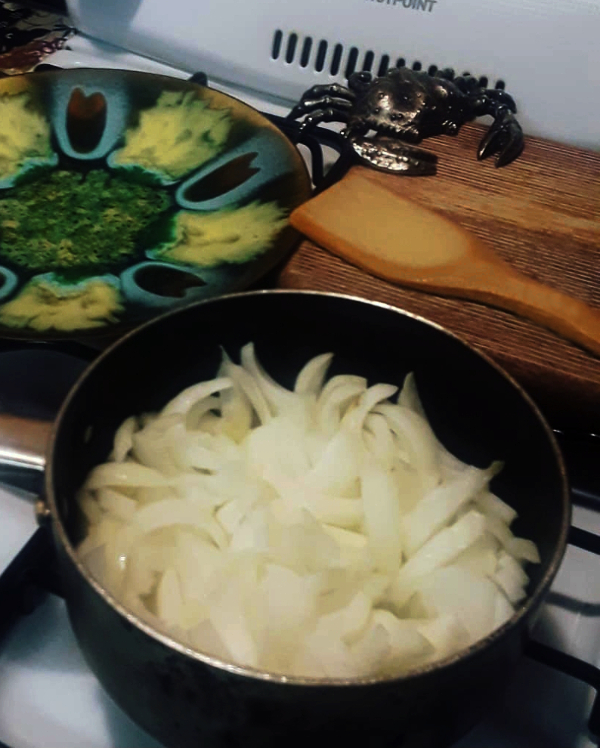
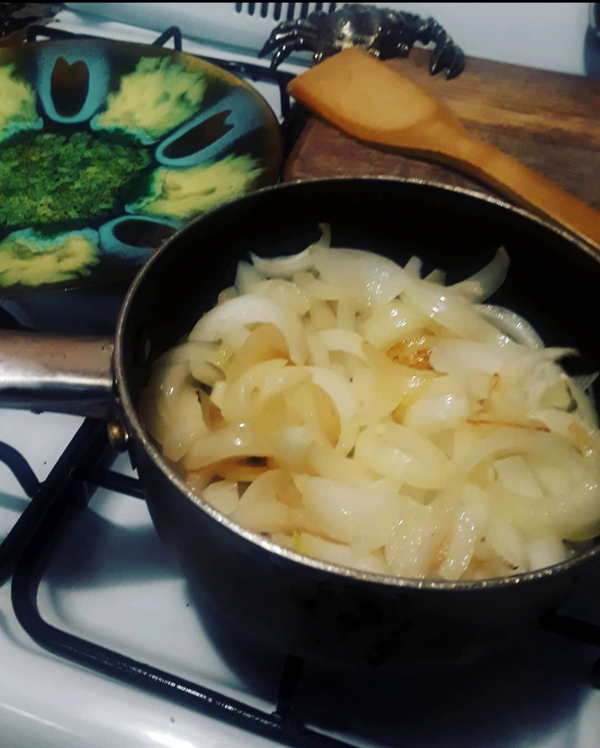
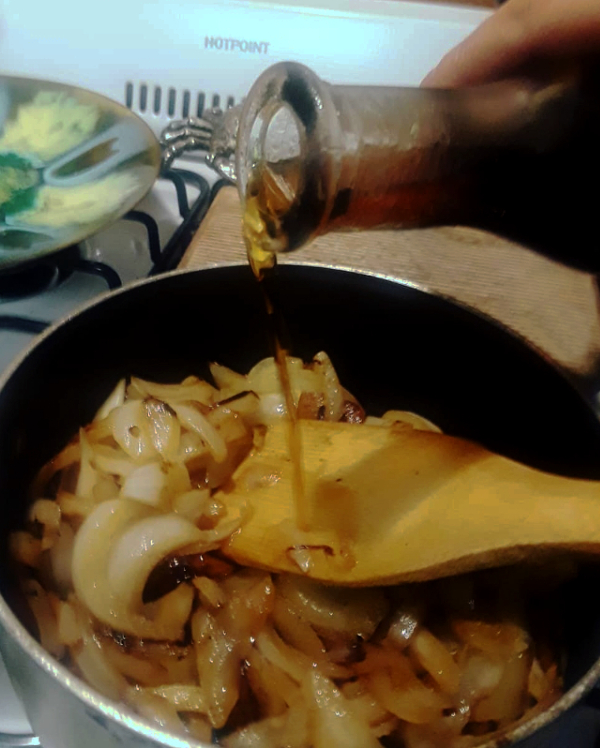
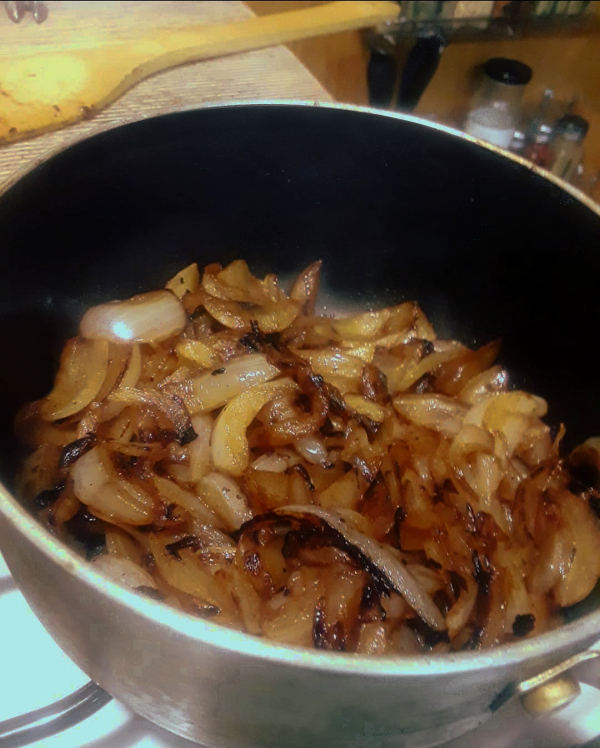
 Broccoli is visually similar to but very different from the closely related cauliflower. Broccoli can be eaten either raw or cooked, and is a rich source of the vitamins C and K. Broccoli was developed from wild cabbage, like all other brassicas; specifically colewort, or field cabbage around the sixth century BC. Broccoli has its primitive origins in the Roman Empire, and by the 18th century was spread to northern Europe, later brought to North America by Italian immigrants in the 19th century. After the Second World War, several varieties were cultivated, including 'Premium Crop,' "Packman," and "Marathon." Violet, yellow and white varieties of broccoli have also been created, but they are very rare.
Broccoli is visually similar to but very different from the closely related cauliflower. Broccoli can be eaten either raw or cooked, and is a rich source of the vitamins C and K. Broccoli was developed from wild cabbage, like all other brassicas; specifically colewort, or field cabbage around the sixth century BC. Broccoli has its primitive origins in the Roman Empire, and by the 18th century was spread to northern Europe, later brought to North America by Italian immigrants in the 19th century. After the Second World War, several varieties were cultivated, including 'Premium Crop,' "Packman," and "Marathon." Violet, yellow and white varieties of broccoli have also been created, but they are very rare. 



























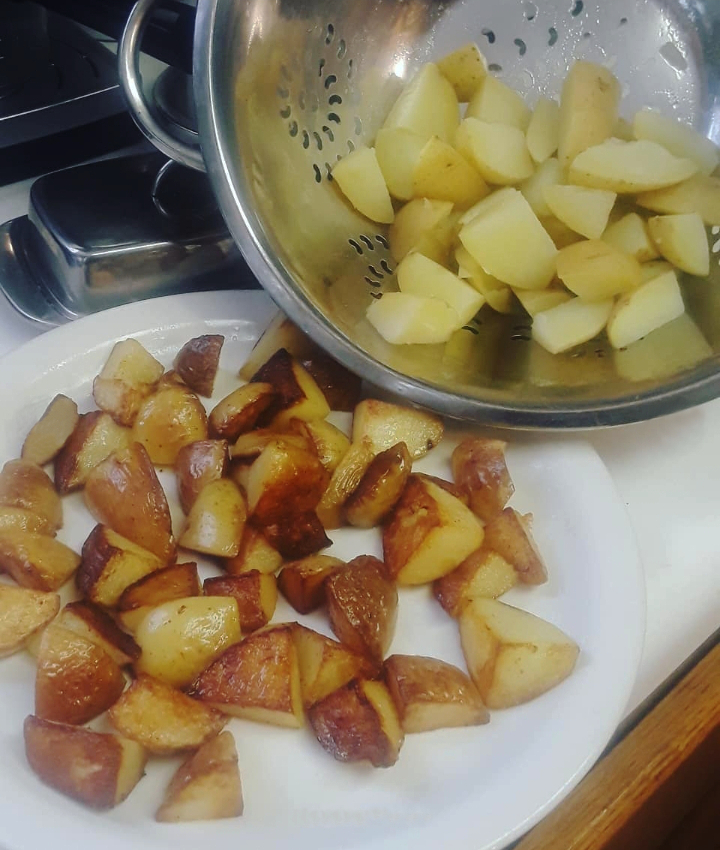






 Restaurants
Restaurants